Initial Field Validation of Poroelastic Pavement Made with Crumb Rubber, Mineral Aggregate and Highly Polymer-Modified Bitumen
Abstract
1. Introduction
2. Materials and Methods
3. Construction of Trial Sections
- Adding crumb rubber to the pugmill of the asphalt batch plant by means of belt conveyor Normally used for adding reclaimed asphalt pavement;
- Mixing of the poroelastic mixture in ordinary pugmill of the asphalt plant;
- Using typical asphalt paver for placing a layer of the poroelastic mixture;
- Relation between compaction degree in the field with laboratory compaction results.
- Section 1—Poroelastic SEPOR-D-PSMA5 W4 mixture laid on even (not milled) surface of the binder course, covered with tack coat and glass geogrid reinforcing layer;
- Section 2—Poroelastic mixture laid on longitudinally milled surface of the binder course, with tack coat and glass geogrid reinforcing layer;
- Section 3—Poroelastic mixture laid on longitudinally milled surface of the binder course, with tack coat only (without glass geogrid reinforcing layer);
- Section 4—Poroelastic mixture laid on even (not milled) surface of the binder course, with tack coat only (without glass geogrid reinforcing layer);
- Section 5—Reference section with typical SMA 8 (Stone Mastic Asphalt with a maximum grain size of 8 mm) wearing course laid on even surface of the binder course, with tack coat only.
- Typical wearing course made of SMA 8 mixture with modified bitumen 45/80-55;
- Porous asphalt wearing course PA 11 with neat bitumen 50/70;
- Poroelastic wearing course made of poroelastic mixture PERS with polyurethane binder;
- Poroelastic wearing course made of designed SEPOR-D-PSMA5 W4 mixture with highly polymer-modified binder HiMA 45/80-80.
4. Field Validation of Poroelastic Pavement Properties
4.1. Volumetric and Mechanical Parameters
- Cylindrical specimens with 100 mm diameter, compacted in laboratory (Marshall compactor, 2 × 50 blows), loose mix were collected during laying;
- Cylindrical specimens with 150 mm diameter, drilled out from the compacted layer.
4.2. Rolling Resistance
4.3. Acoustical Properties
4.4. Impact on the Spread of Fuel Spills Fires
5. Conclusions
- (1)
- Highly polymer-modified asphalt binders (HiMA 45/80-80) are promising in terms of obtaining reliable and durable poroelastic mixtures and can be used as a replacement of the previously used polyurethane binders, which are expensive and difficult to use.
- (2)
- The adopted test procedure for poroelastic mixtures, which involved testing of inlayer shear strength, enabled the design of mixtures with a proper level of internal cohesion and, simultaneously, acceptable poroelastic characteristics.
- (3)
- Field trials that involved ordinary asphalt batch plants have shown that production of the poroelastic mixture with the addition of 15% of crumb rubber using installation normally used for reclaimed asphalt pavement is possible.
- (4)
- Laying and compacting of the poroelastic mixture with ordinary paving machines and rollers was not complicated and did not require any modifications in the equipment, but compaction methods must be revised to obtain better consistency of field compaction levels with laboratory results.
- (5)
- Poroelastic mixtures produced in the plant are more open (have a higher air voids content) compared to poroelastic mixtures produced in the laboratory, even if the same compaction method was used; Marshal hammer in the laboratory.
- (6)
- Poroelastic mixtures produced in the plant characterized 30–40% lower cohesion measured by the Leutner apparatus as an inlayer shear strength compared to the mixture produced in the laboratory.
- (7)
- Poroelastic pavements of the SEPOR type tested so far exhibit lower noise reduction 6–9 dB instead of the desired 10–12 dB, so further changes to the mixture and paving technology should be introduced.
- (8)
- Rolling resistance of passenger car tires on SEPOR type pavements is at about 10% higher than on reference road pavement SMA8.
- (9)
- SEPOR type pavement exhibit very promising properties in case of spill fuel fires hampering the spread of fire and giving a considerable time margin for the evacuation of passengers.
Author Contributions
Funding
Acknowledgments
Conflicts of Interest
References
- Sandberg, U.; Ejsmont, J. Tyre/Road Noise Reference Book; Informex: Kisa, Sewden, 2002. [Google Scholar]
- Sandberg, U.; Goubert, L.; Biligiri, K.P.; Kalman, B. State-of-the-Art Regarding Poroelastic Road Surfaces, (Deliverable D 8.1) Project PERSUADE; VTI: Linköping, Sweden, 2010. [Google Scholar]
- Goubert, L. Traffic Noise: Can the Poro-Elastic Road Surface Help. Informal Document GRB-62-23. 2015. Available online: https://www.unece.org/fileadmin/DAM/trans/doc/2015/wp29grb/GRB-62-23e.pdf (accessed on 12 December 2019).
- Świeczko-Żurek, B.; Ejsmont, J.; Motrycz, G.; Stryjek, P. Risks related to car fire on innovative Poroelastic Road Surfaces—PERS. Fire Mater. 2015, 39, 95–108. [Google Scholar] [CrossRef]
- Leng, C.; Lu, G.; Gao, J.; Liu, P.; Xie, X.; Wang, D. Sustainable green pavement using bio-based polyurethane binder in tunnel. Materials 2019, 12, 1990. [Google Scholar] [CrossRef] [PubMed]
- Voskuilen, J.L.M. Causes of premature ravelling failure in porous asphalt. In Proceedings of the 6th RILEM Symposium PTEBM’03, Zurich, Switzerland, 14–16 April 2003; pp. 191–197. [Google Scholar] [CrossRef]
- Bendtsen, H.; Skov, H. Performance of Eight Poroelastic Test Sections. WP 5 Monitoring. 2015. Available online: http://www.persuadeproject.eu/ (accessed on 14 March 2020).
- Huurman, M.; Mo, L.T.; Woldekidan, M.F. Unravelling porous asphalt concrete, towards a mechanistic material design tool. Road Mater. Pavement Des. 2009, 10, 233–262. [Google Scholar] [CrossRef]
- Manrique-Sanchez, L.; Caro, S.; Arámbula-Mercado, E. Numerical modelling of ravelling in porous friction courses (PFC). Road Mater. Pavement Des. 2018, 19, 668–689. [Google Scholar] [CrossRef]
- Jacobson, T.; Sandberg, U.; Viman, L. How do we improve the durability of porous asphalt? In Proceedings of the 6th Eurasphalt Eurobitume Congress, Prague, Czech Republic, 1–3 June 2016. [Google Scholar] [CrossRef]
- Wu, J.P.; Herrington, P.R.; Alabaster, D. Long-term durability of epoxy-modified open-graded porous asphalt wearing course. Int. J. Pavement Eng. 2017, 8436, 1–8. [Google Scholar] [CrossRef]
- Airey, G.D.; Rahman, M.M.; Collop, A.C. Absorption of bitumen into crumb rubber using the basket drainage method. Int. J. Pavement Eng. 2003, 4, 105–119. [Google Scholar] [CrossRef]
- Shen, J.; Li, B.; Xie, Z. Interaction between crumb rubber modifier (CRM) and asphalt binder in dry process. Constr. Build. Mater. 2017, 149, 202–206. [Google Scholar] [CrossRef]
- Moreno, F.; Rubio, M.C.; Martinez-Echevarria, M.J. The mechanical performance of dry-process crumb rubber modified hot bituminous mixes: The influence of digestion time and crumb rubber percentage. Constr. Build. Mater. 2012, 26, 466–474. [Google Scholar] [CrossRef]
- Srirangam, S.K.; Anupam, K.; Casey, D.; Liu, X.; Kasbergen, C.; Scarpas, A.; Researcher, P.D.; Researcher, S.; Engineer, H.D.; House, B.; et al. Evaluation of structural performance of poro-elastic road surfacing pavement subjected to rolling truck tire loads. Transp. Res. Rec. J. Transp. Res. Board. 2016, 2591, 42–56. [Google Scholar] [CrossRef]
- Wang, D.; Schacht, A.; Leng, Z.; Leng, C.; Kollmann, J.; Oeser, M. Effects of material composition on mechanical and acoustic performance of poroelastic road surface (PERS). Constr. Build. Mater. 2017, 135, 352–360. [Google Scholar] [CrossRef]
- James, T.; Watson, D.; Taylor, A.; Tran, N.; Rodezno, C. Improving cohesiveness of porous friction course (PFC) asphalt mixtures. Assoc. Asph. Paving Technol. 2017. [Google Scholar] [CrossRef]
- Świeczko-Żurek, B.; Jaskula, P.; Ejsmont, J.; Kędzierska, A.; Czajkowski, P. Rolling resistance and tyre/road noise on rubberised asphalt pavement in Poland. Road Mater. Pavement Des. 2017, 18, 151–167. [Google Scholar] [CrossRef]
- Wang, D.; Liu, P.; Leng, Z.; Leng, C.; Lu, G.; Buch, M.; Oeser, M. Suitability of PoroElastic Road Surface (PERS) for urban roads in cold regions: Mechanical and functional performance assessment. J. Clean. Prod. 2017, 165, 1340–1350. [Google Scholar] [CrossRef]
- Kalman, B.; Biligiri, K.P.; Sandberg, U. Project PERSUADE: Optimization of poroelastic road surfaces in the laboratory. In Proceedings of the INTER-NOISE 2011, Osaka, Japan, 4–7 September 2011; pp. 1–9. [Google Scholar]
- Goubert, L.; Sandberg, U. The PERSUADE project: Developing the concept of poroelastic road surface into a powerful tool for abating traffic noise. In Proceedings of the INTER-NOISE 2010, Lisbon, Portugal, 15–16 June 2010; pp. 1–10. [Google Scholar]
- Ejsmont, J.; Świeczko-Żurek, B. Poroelastic material for urban roads wearing courses. In Proceedings of the 3rd International Conference on Materials Engineering and Functional Materials (ICMFM 2019), Hue, Vietnam, 4–6 May 2019. [Google Scholar]
- International Organization for Standardization (ISO). Acoustics—Measurement of the Influence of Road Surfaces on Traffic Noise—Part 3: Reference Tyres; ISO/TS 11819-3:2017; ISO: Genève, Switzerland, 2017. [Google Scholar]
- Świeczko-Żurek, B.; Goubert, L.; Ejsmont, J.; Ronowski, G. Poroelastic road surfaces—State of the art. In Proceedings of the Rubberized Asphalt Rubber, Kruger Park, South Africa, 26–28 September 2018. [Google Scholar]
- Goubert, L. A new test track with the ultra noise reducing poroelastic road surface (PERS) in Gent, Belgium. In Proceedings of the INTER-NOISE, Madrid, Spain, 16–19 June 2019. [Google Scholar]
- Mioduszewski, P. Poroelastic Road Surface—A Promising Road Traffic Noise Abatement Solution; POSTĘPY AKUSTYKI; Marszal, J., Ed.; Polskie Towarzystwo Akustyczne Oddział Gdański: Gdańsk, Poland, 2018; pp. 80–85. [Google Scholar]
- Mioduszewski, P. Raport Techniczny z Badań Drogowych Hałaśliwości Nawierzchni Poroelastycznej Oraz Referencyjnej w Gdańsku na Ulicy Galaktycznej; Project SEPOR Report No. R18-SEPOR PG WM-10; Gdańsk University of Technology: Gdańsk, Poland, 2019. [Google Scholar]
- Meiarashi, S. Porous elastic road surface as an ultimate highway noise measure. In Proceedings of the XXIInd PIARC World Road Congress, Durban, South Afria, 19–25 October 2003; Available online: https://scinapse.io/papers/658997683 (accessed on 27 December 2019).
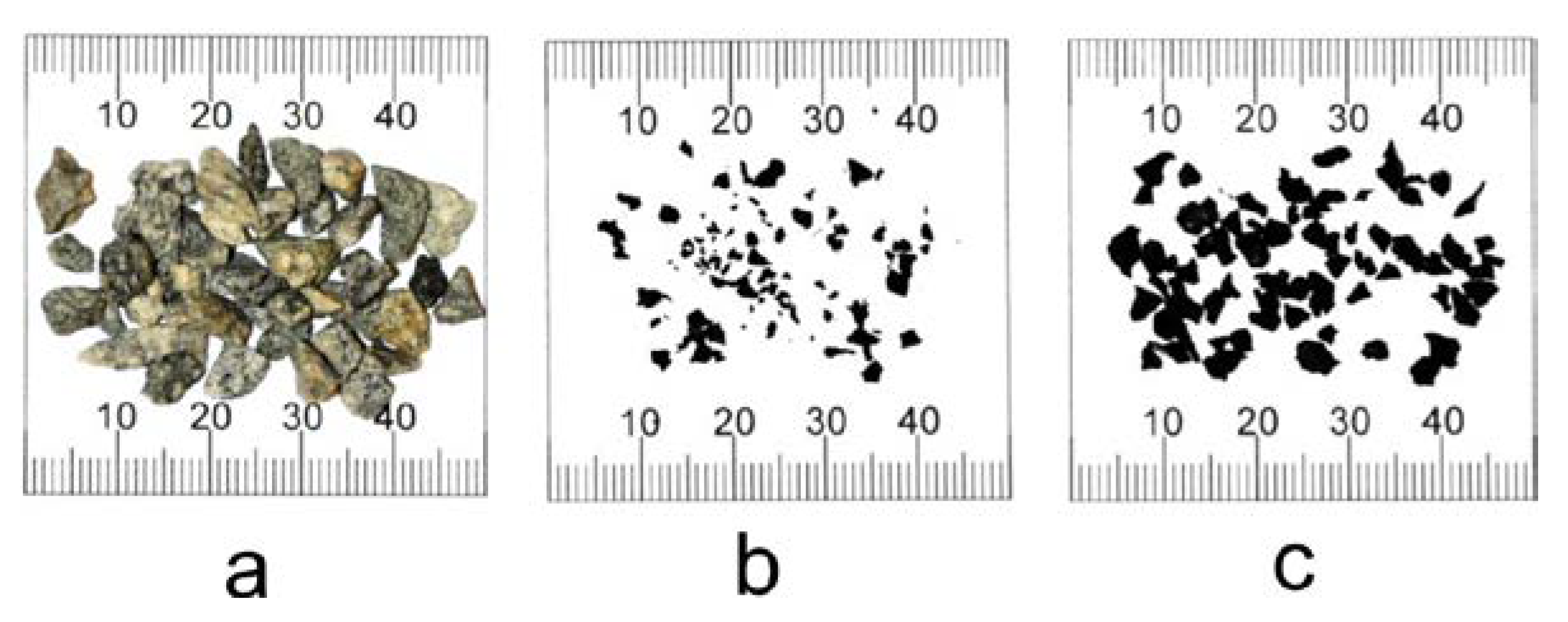
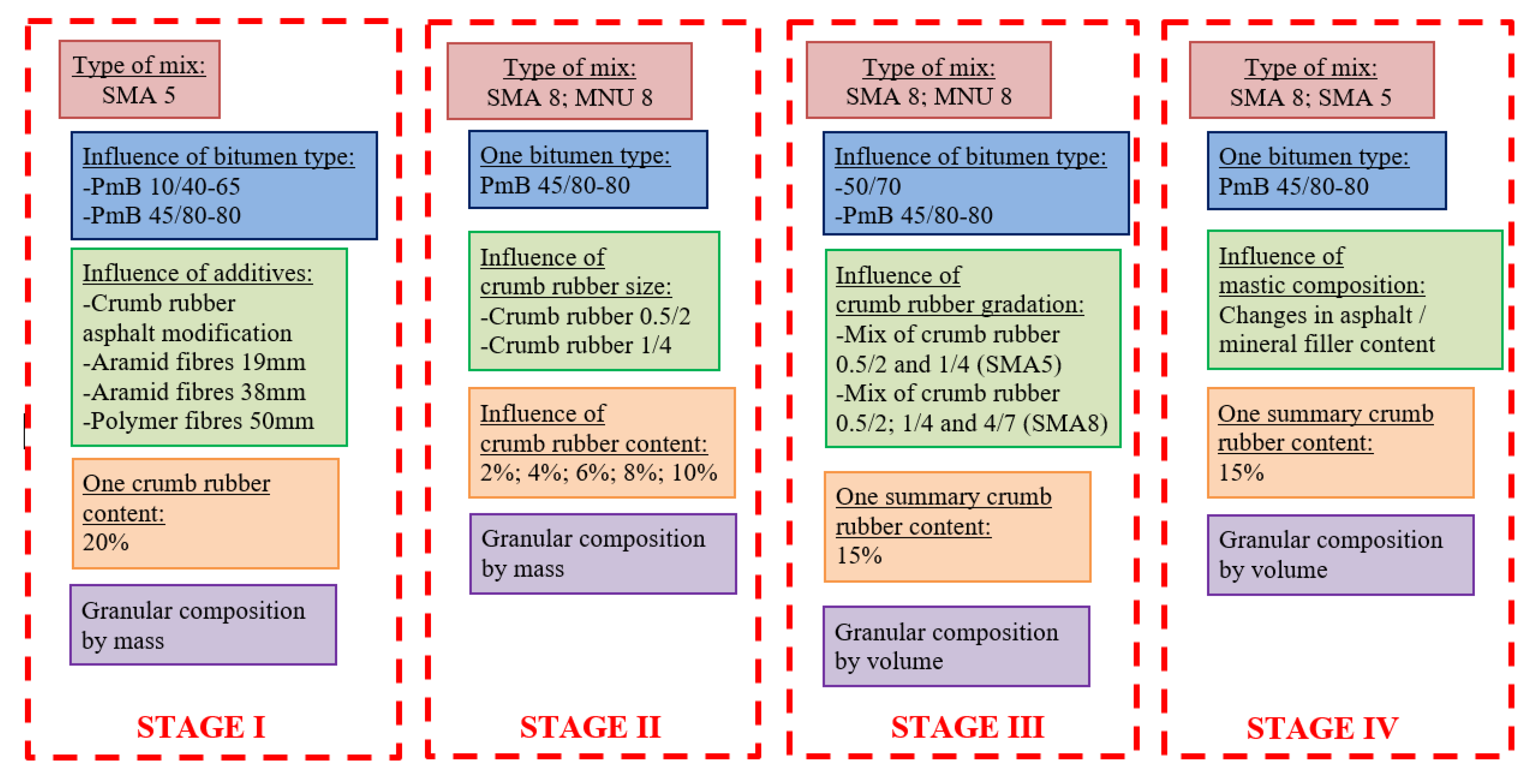
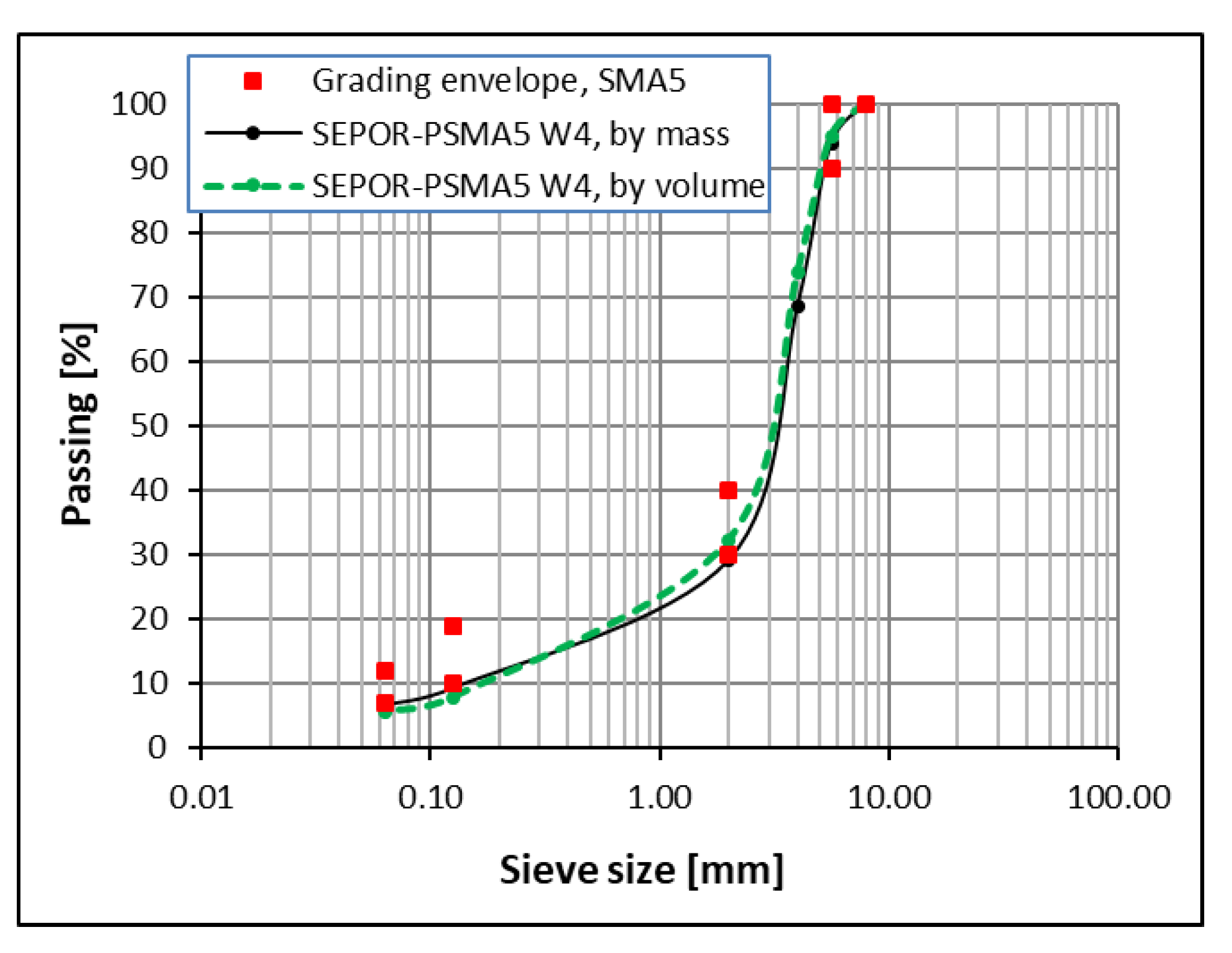



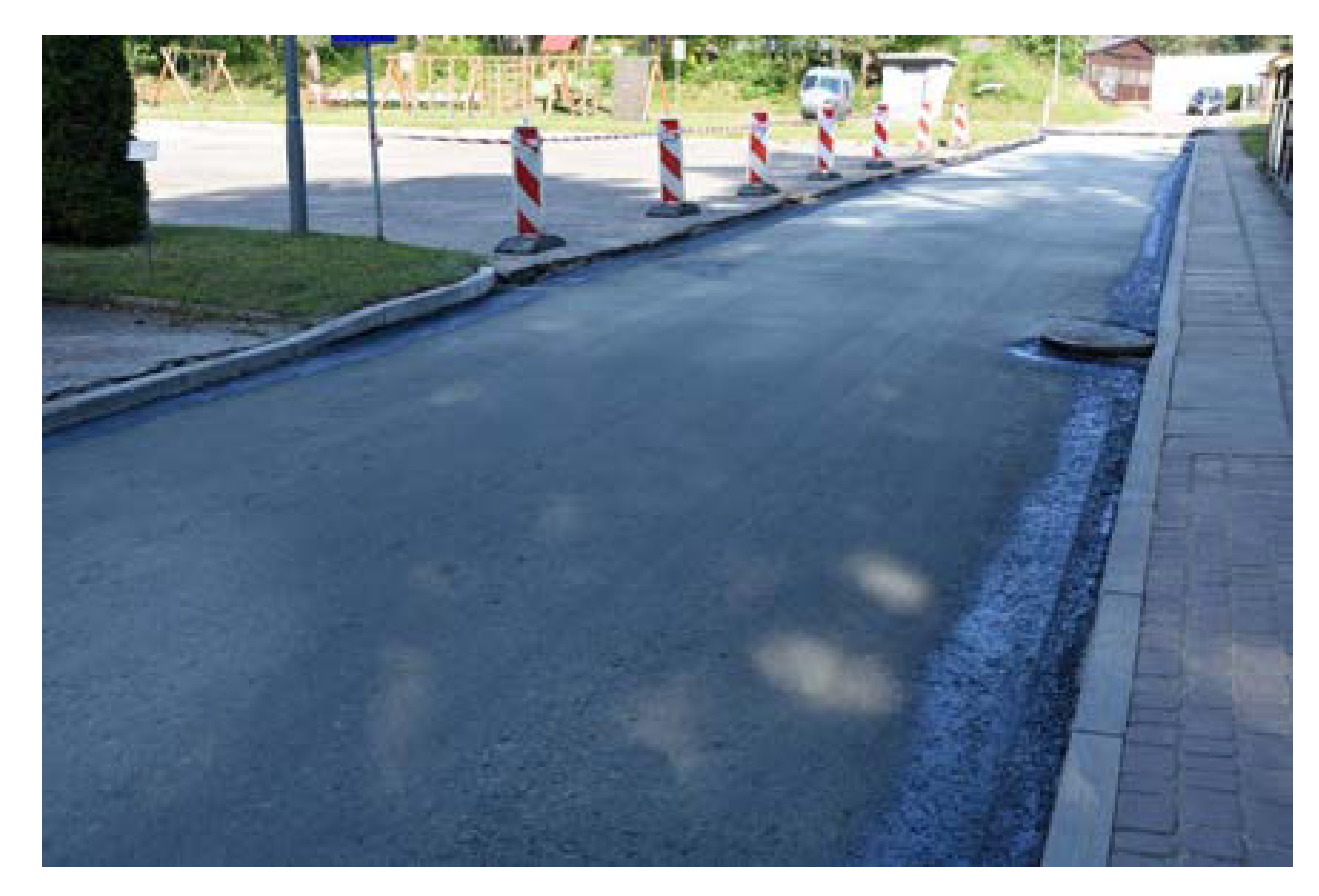
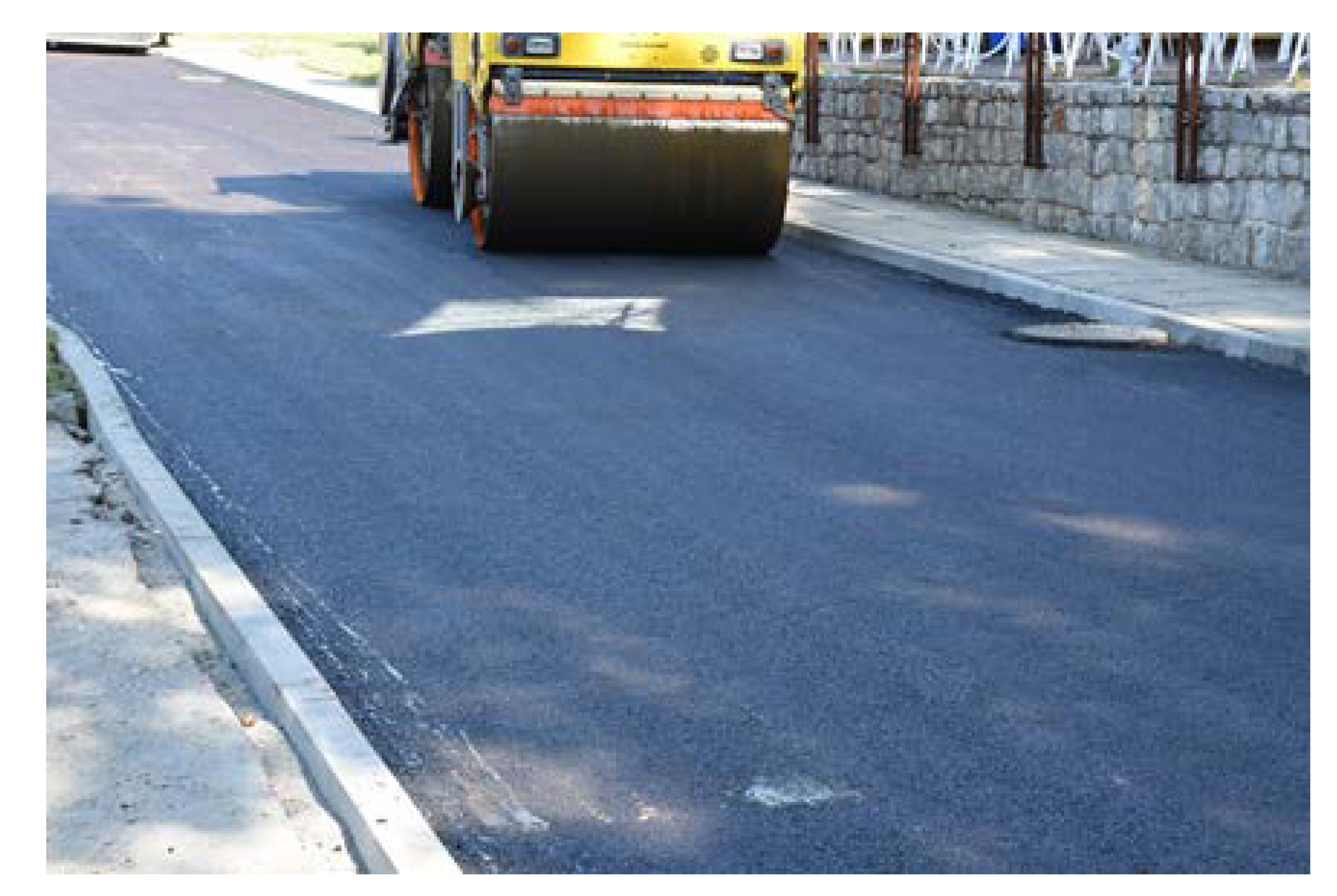
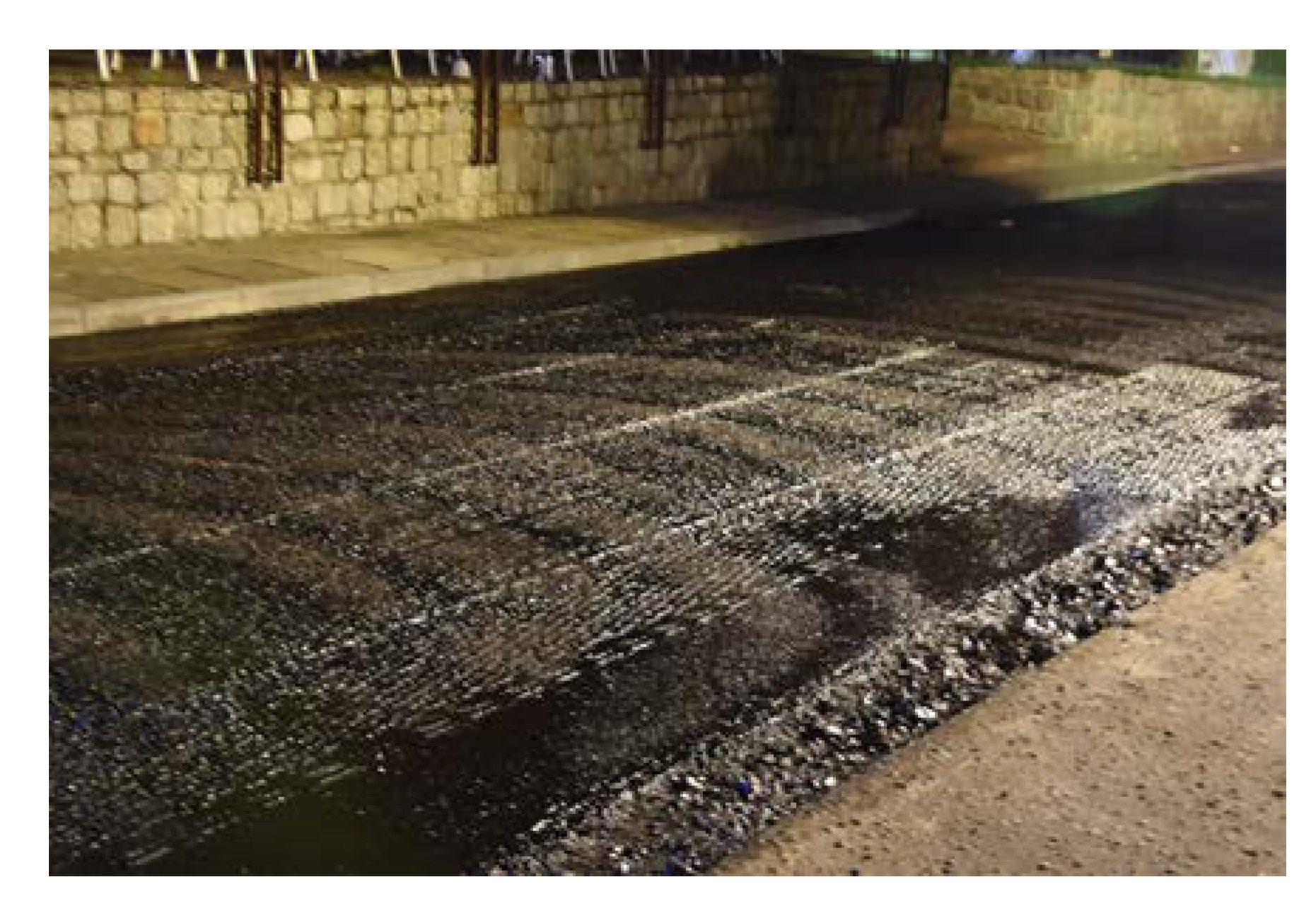
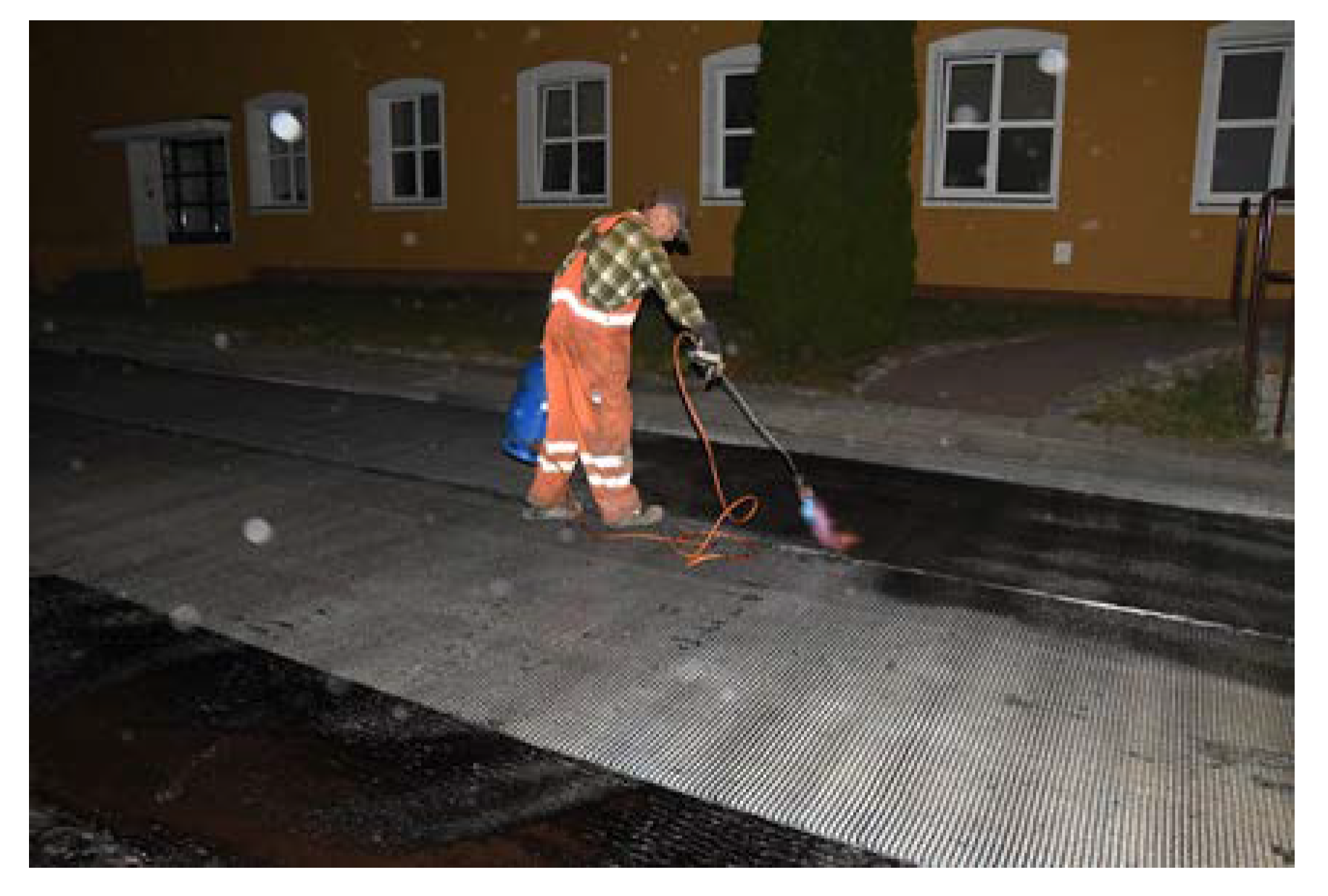

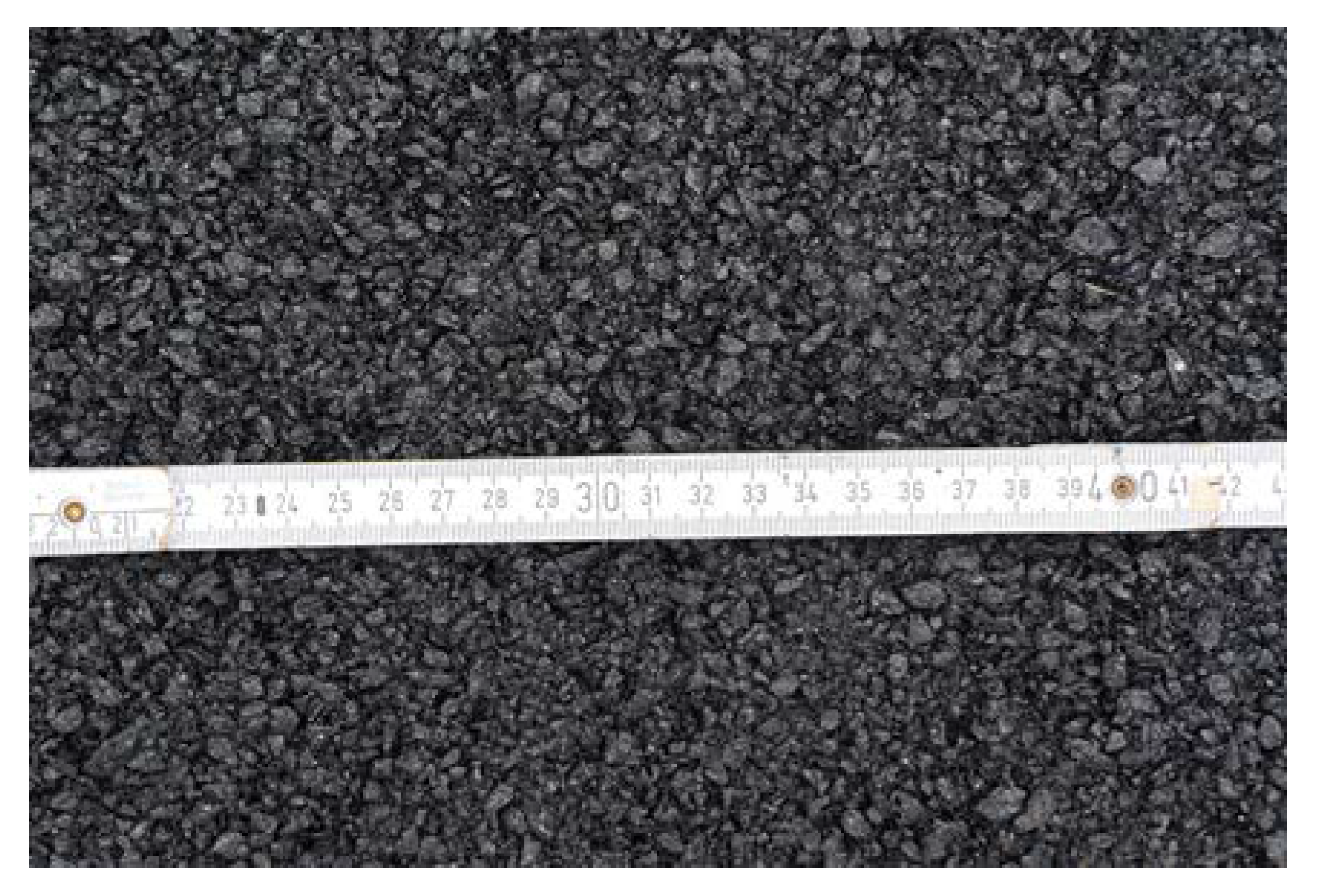
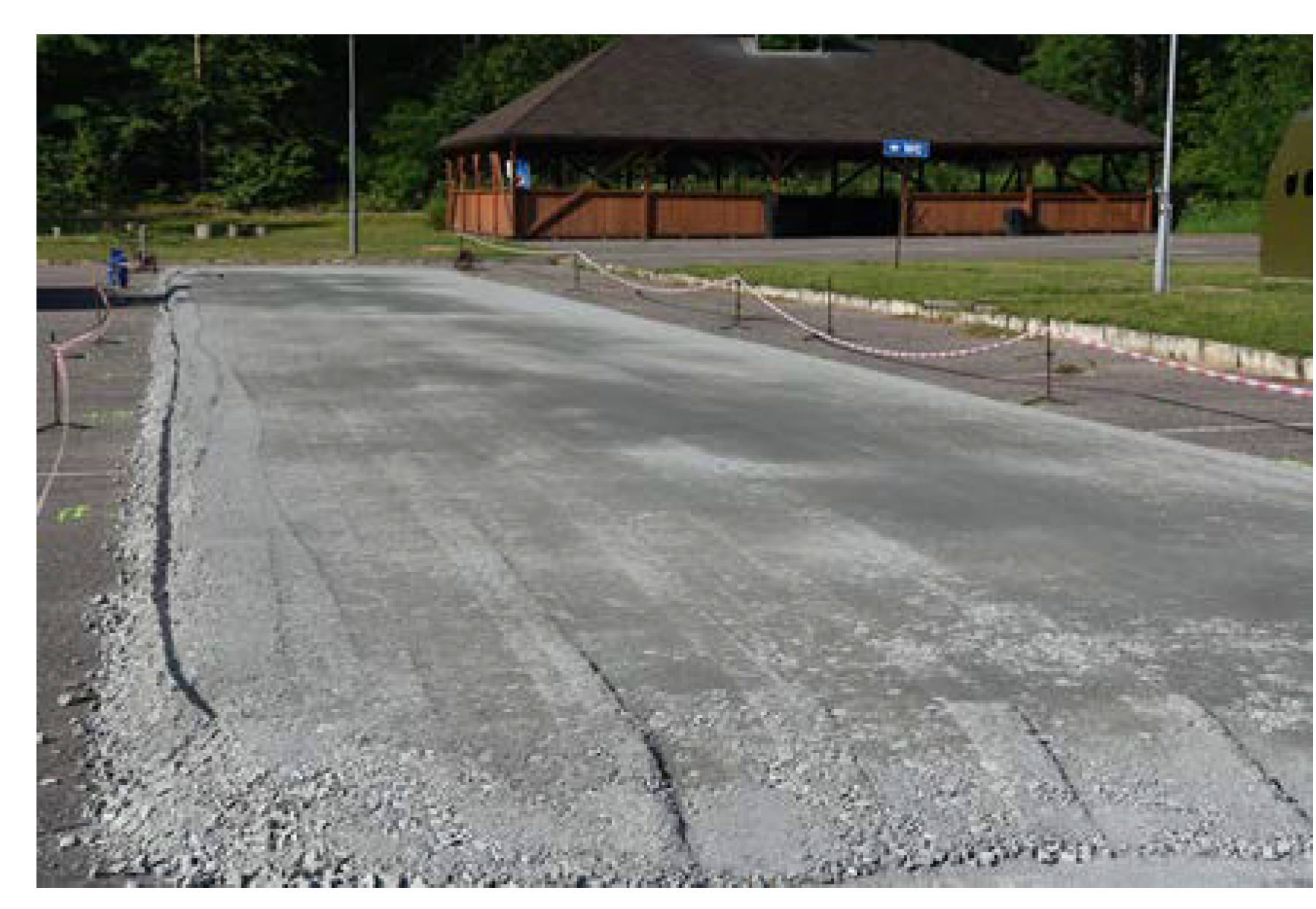
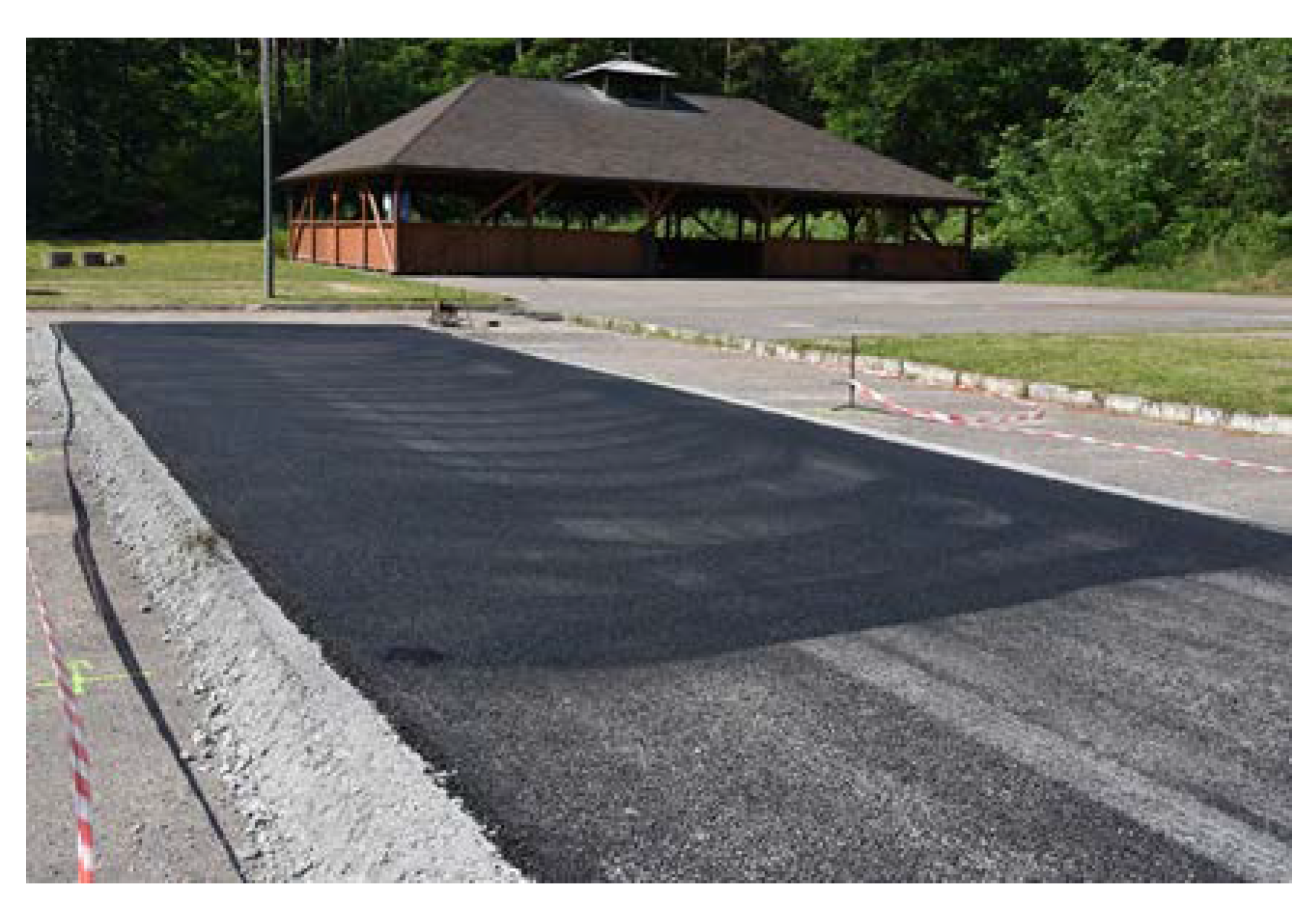
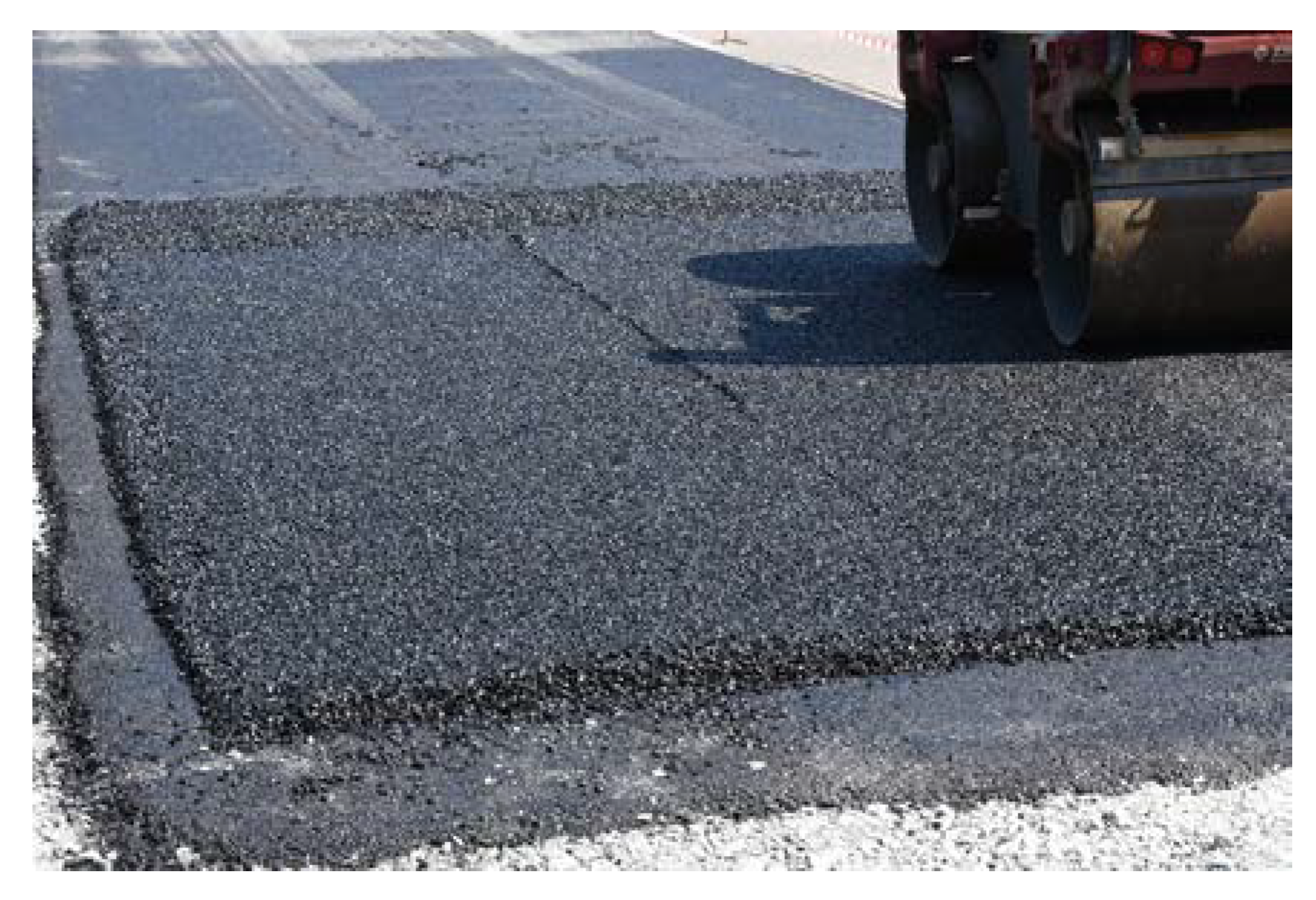
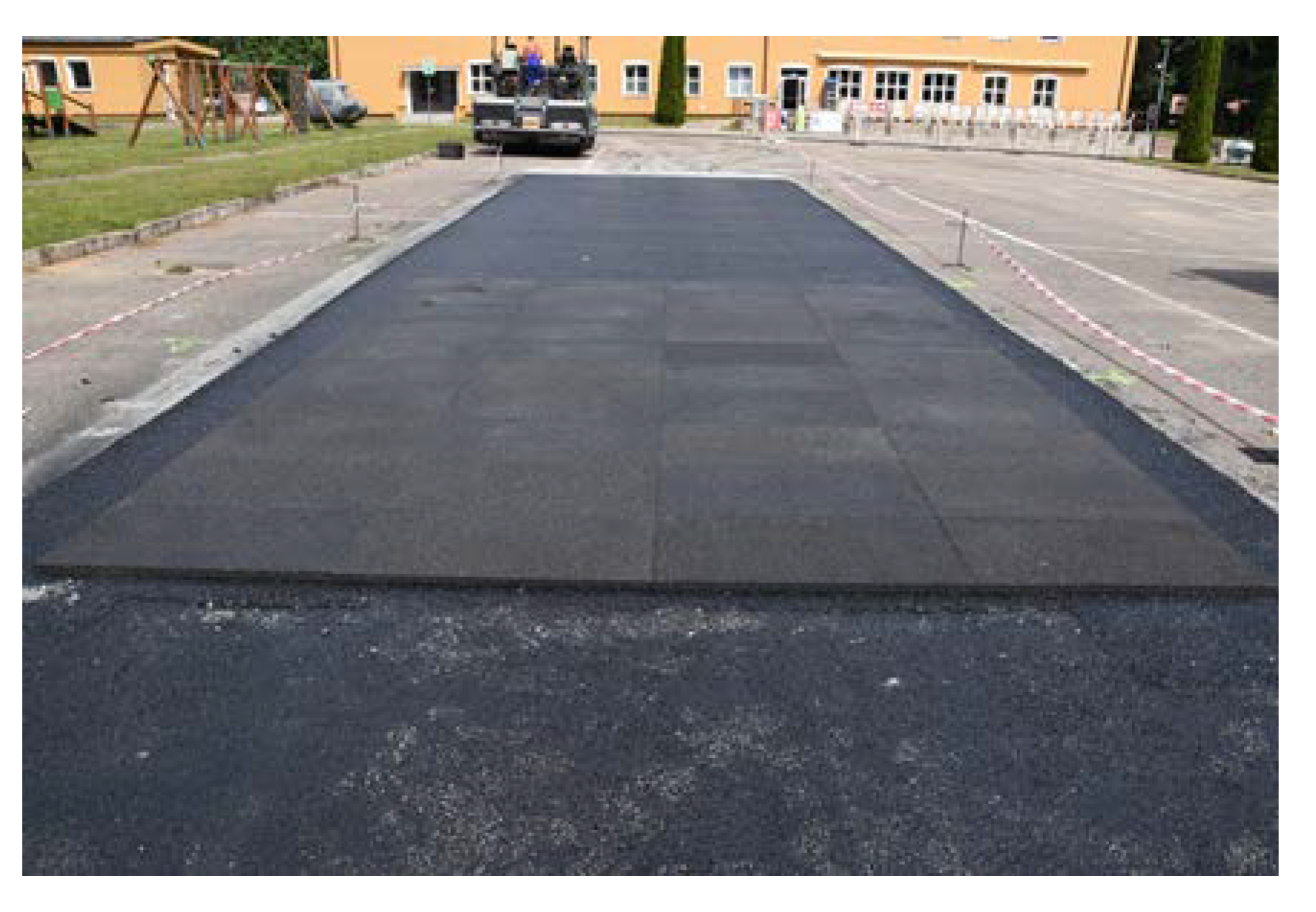
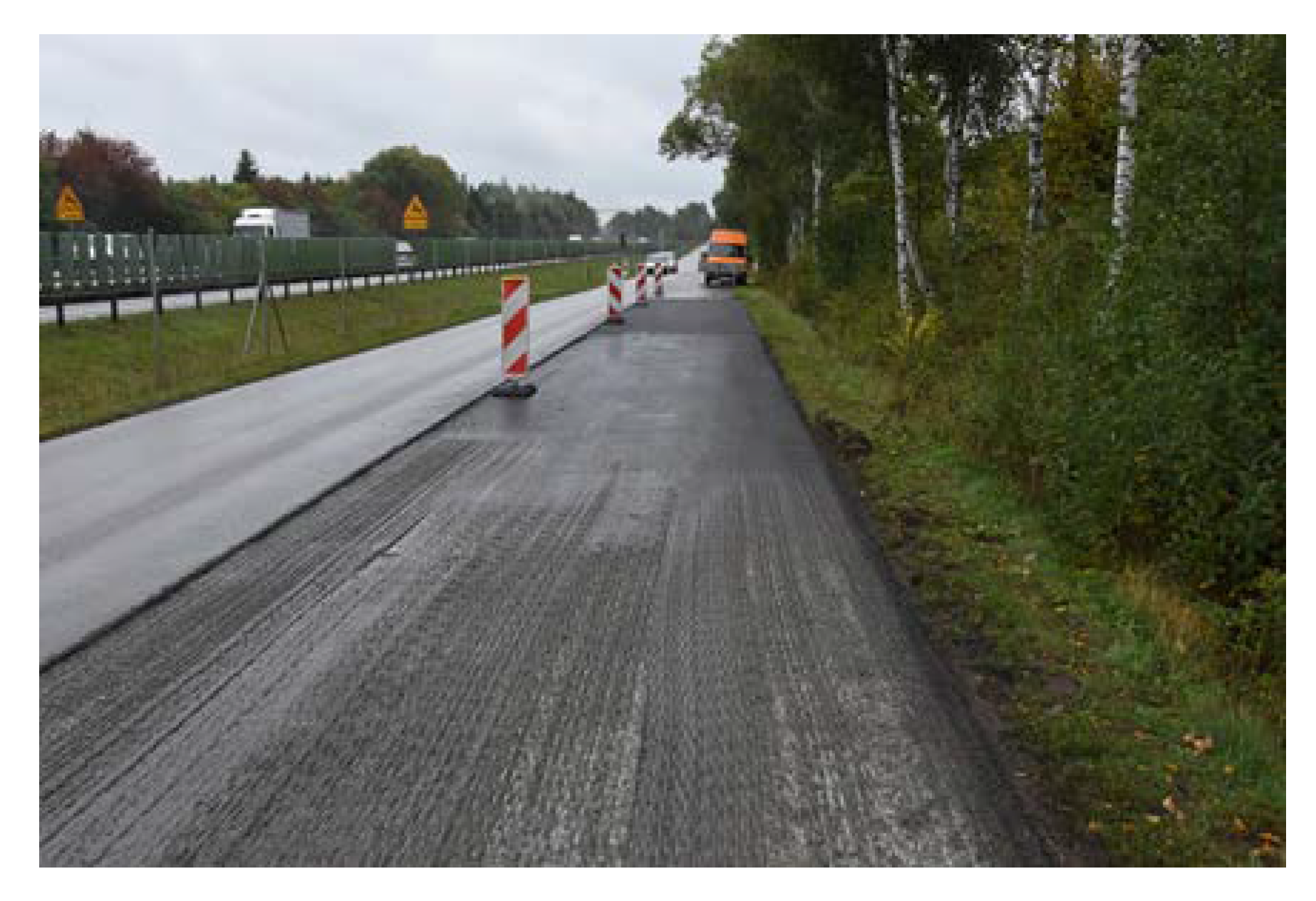

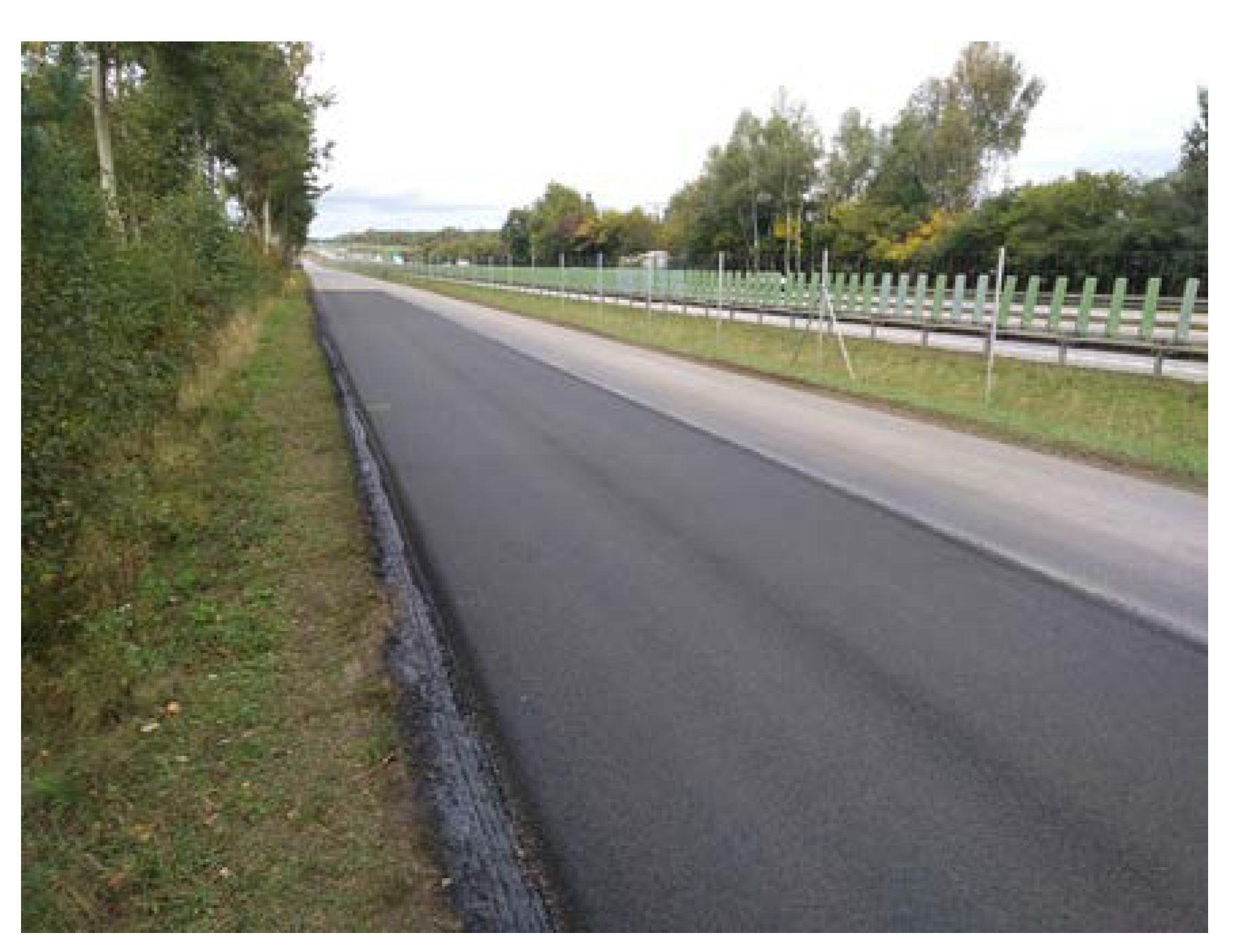
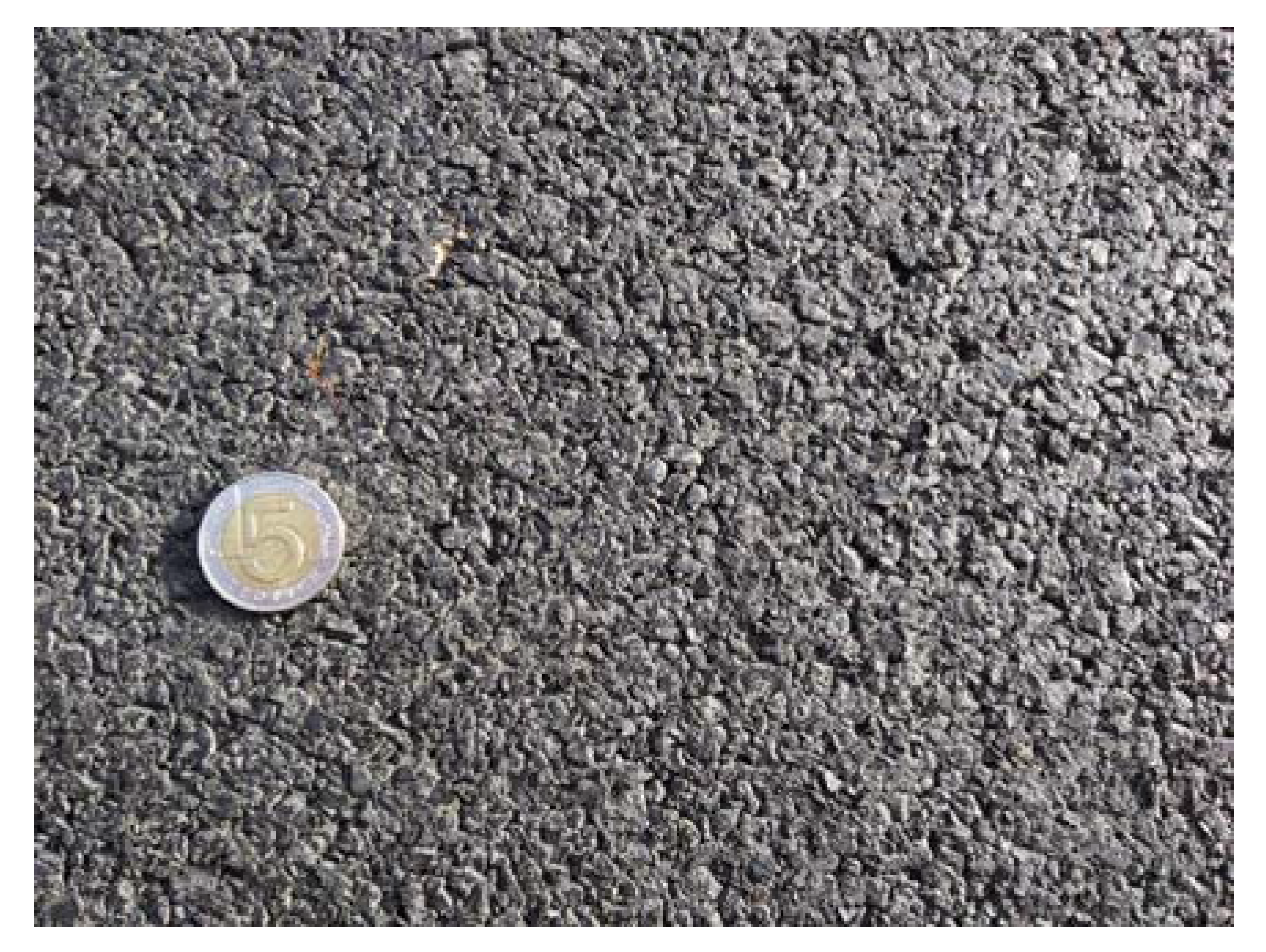
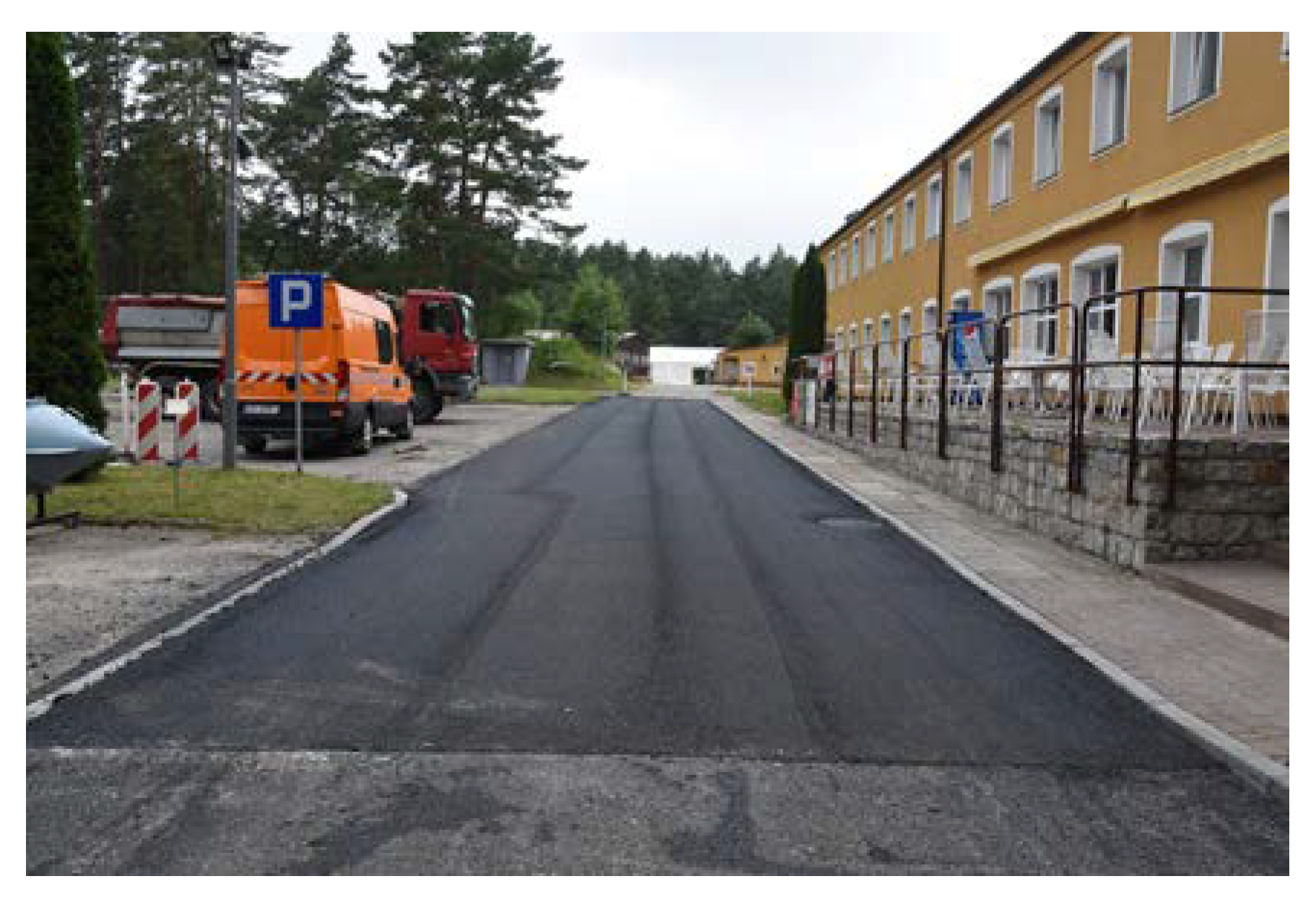
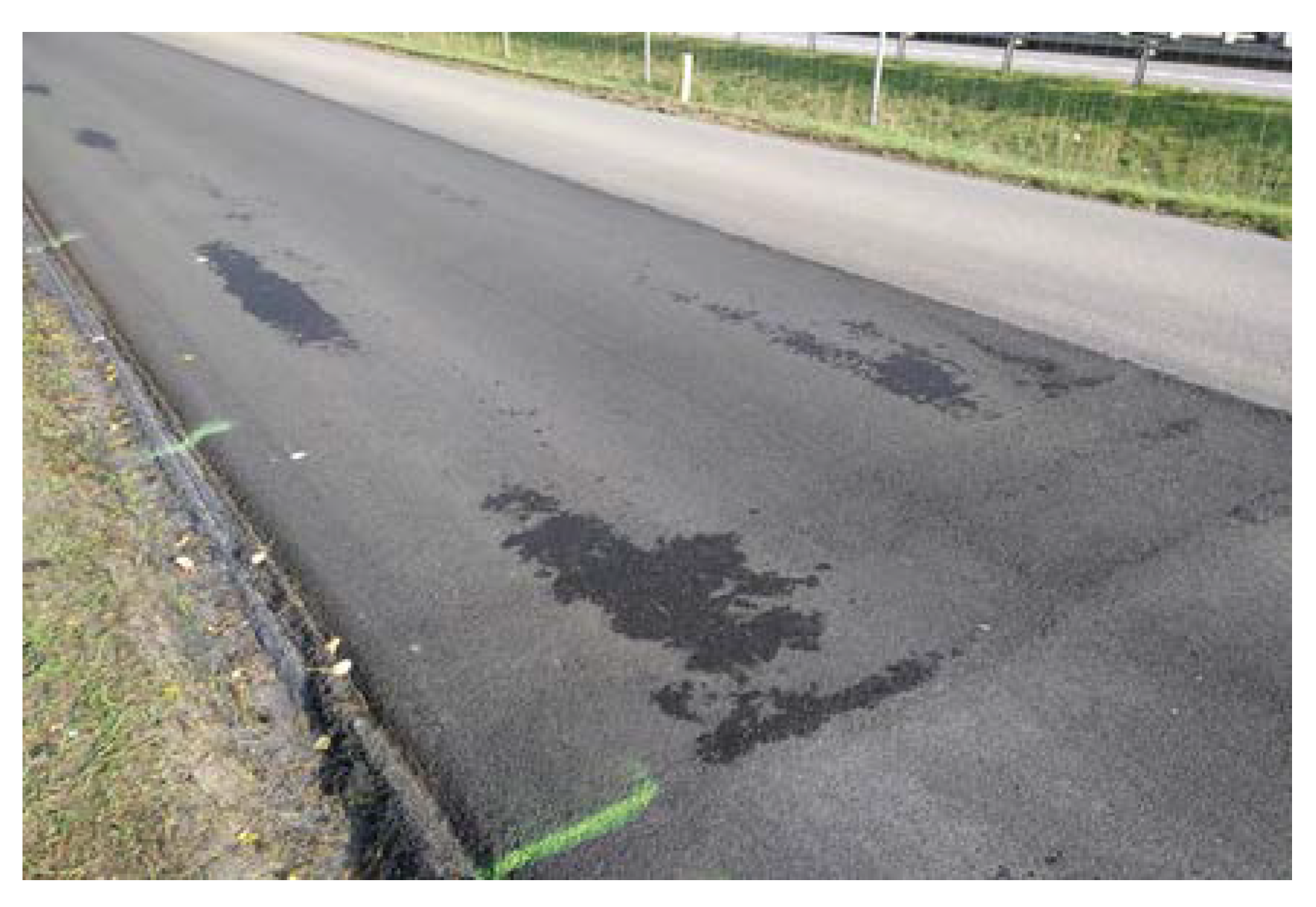
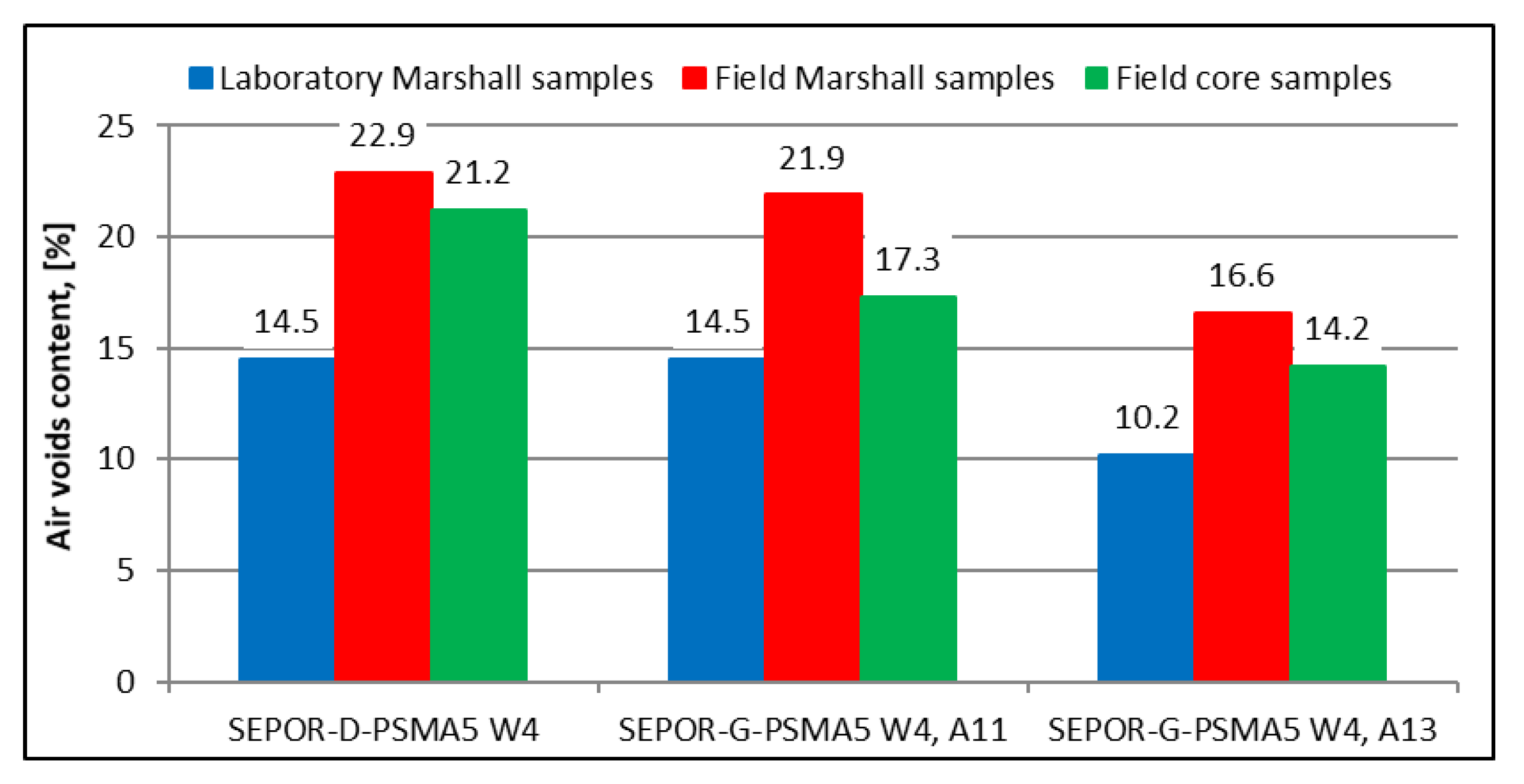
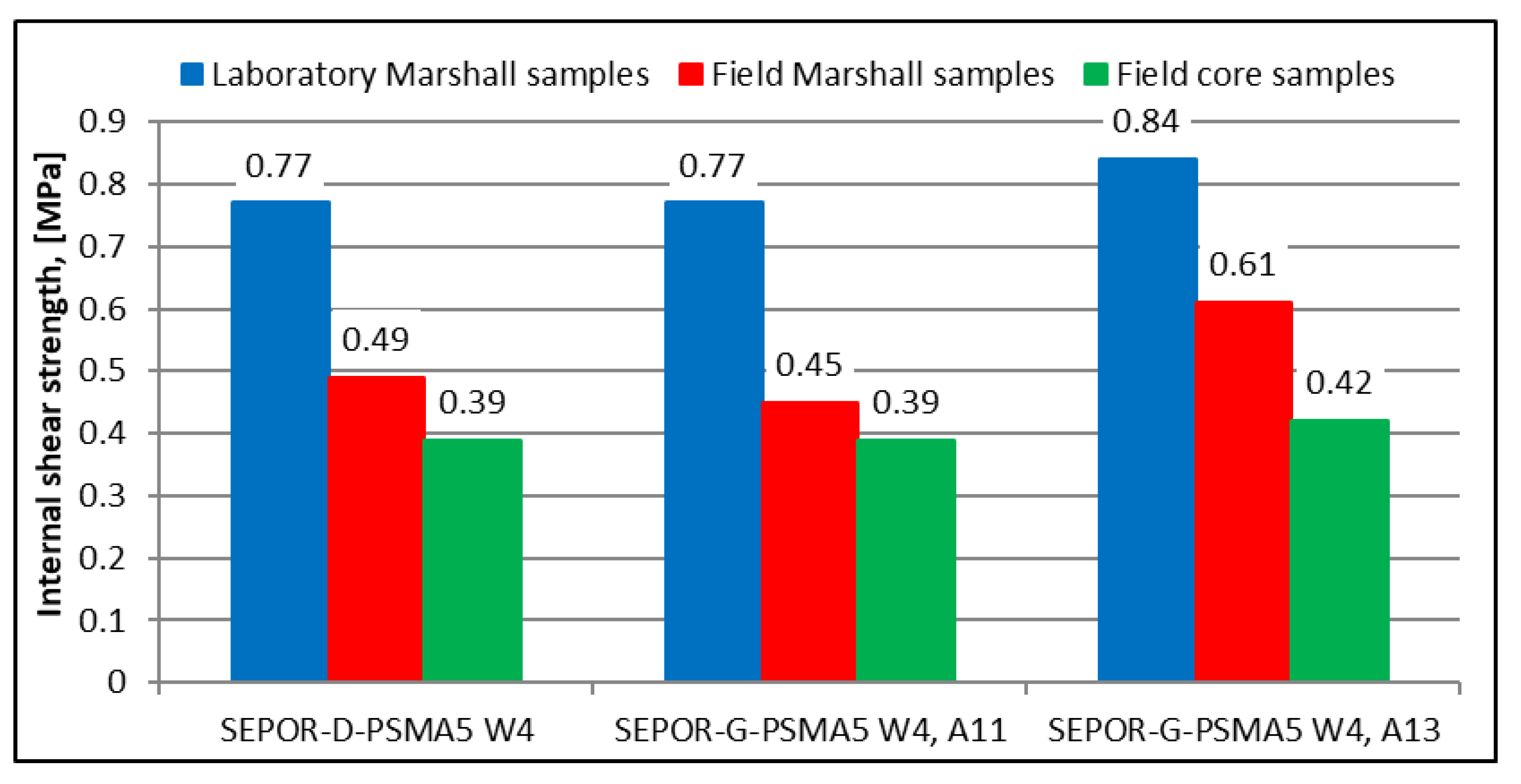
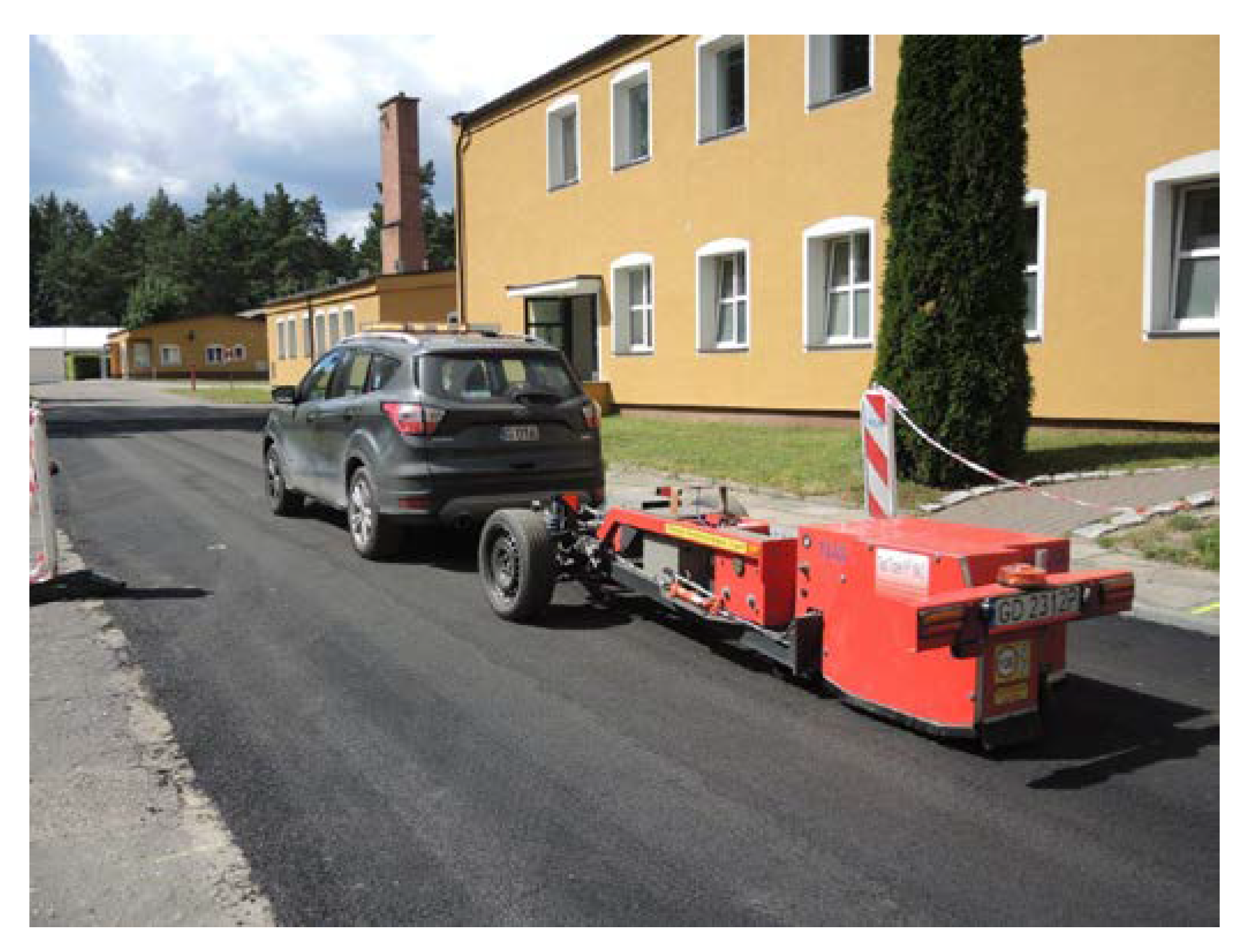
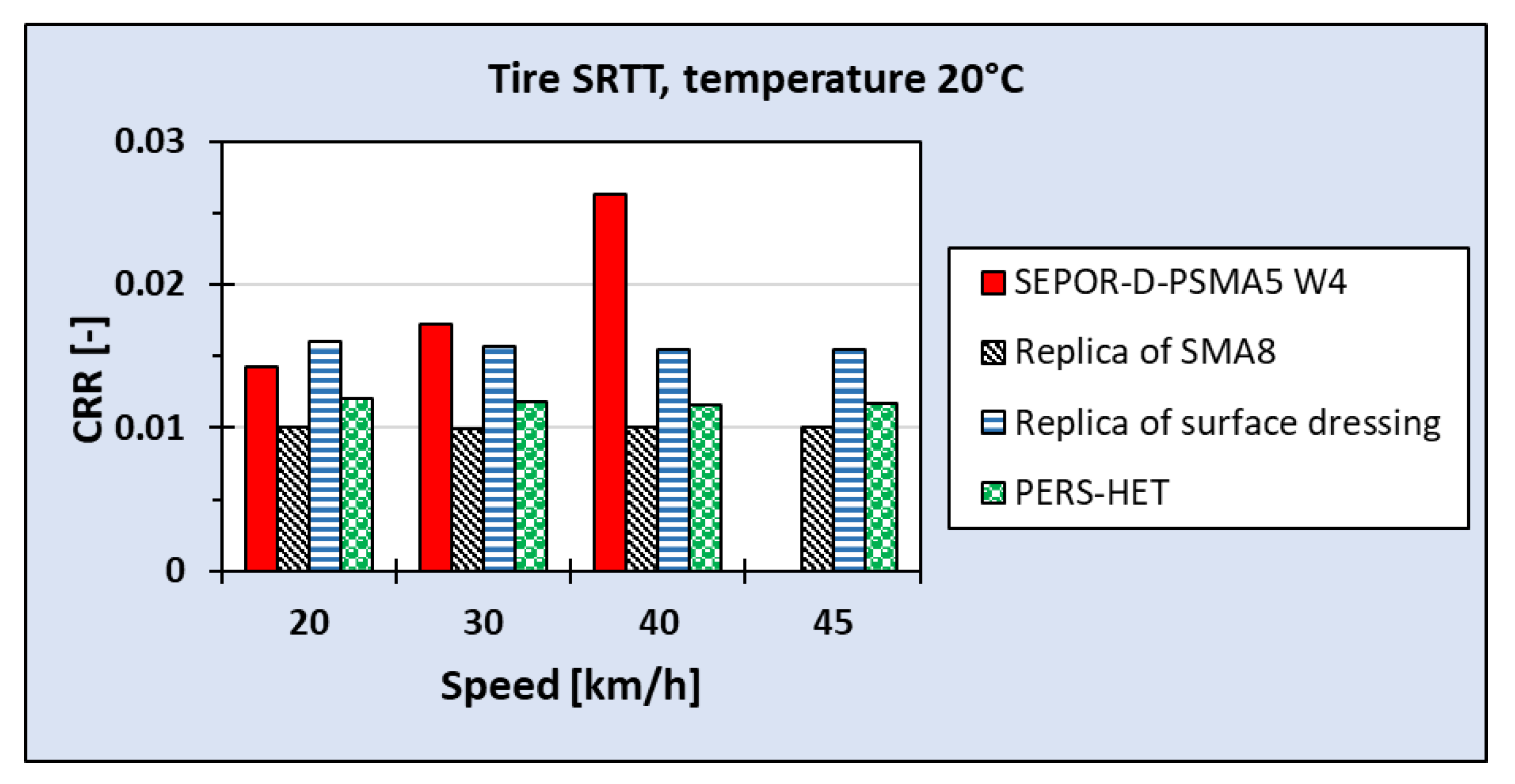
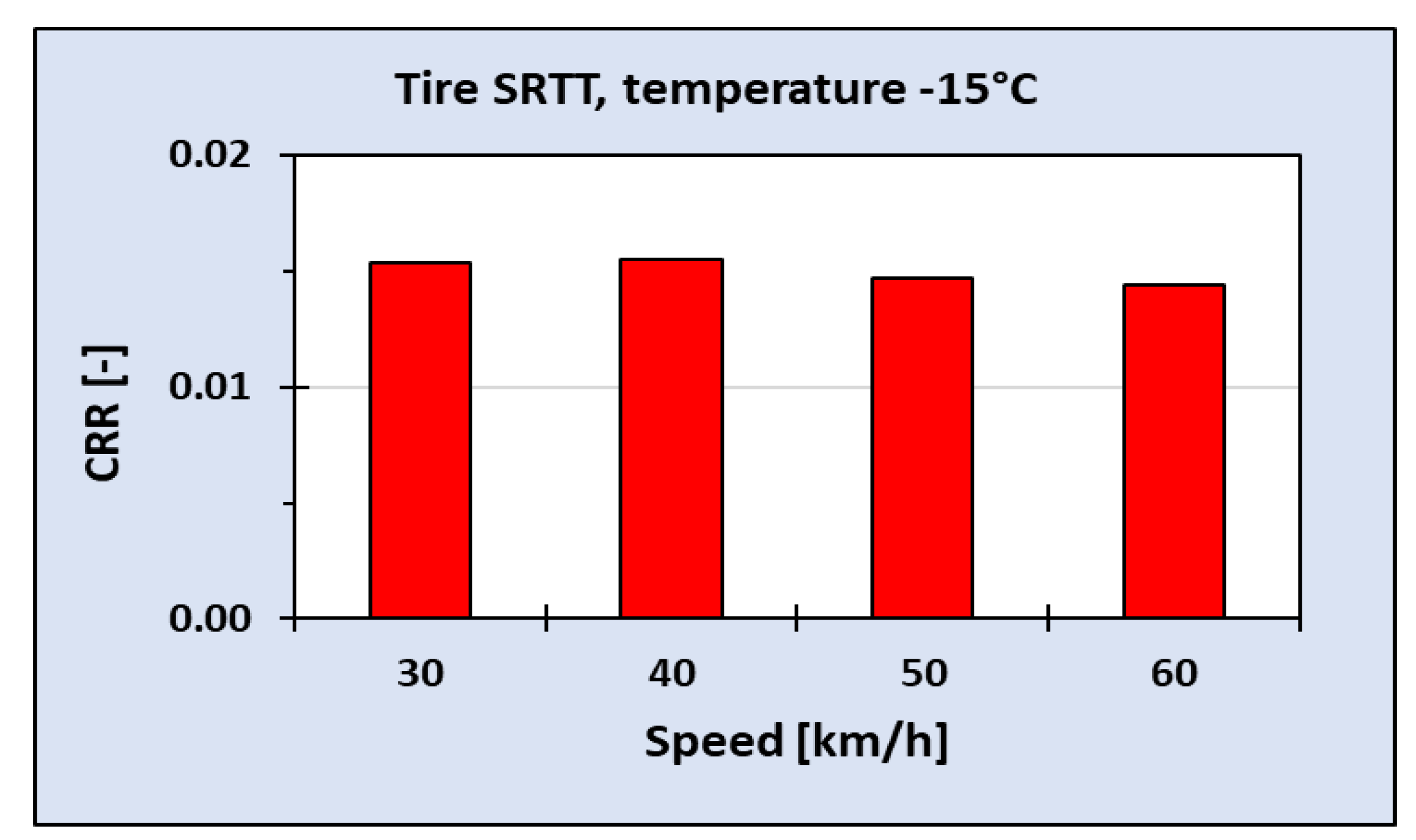
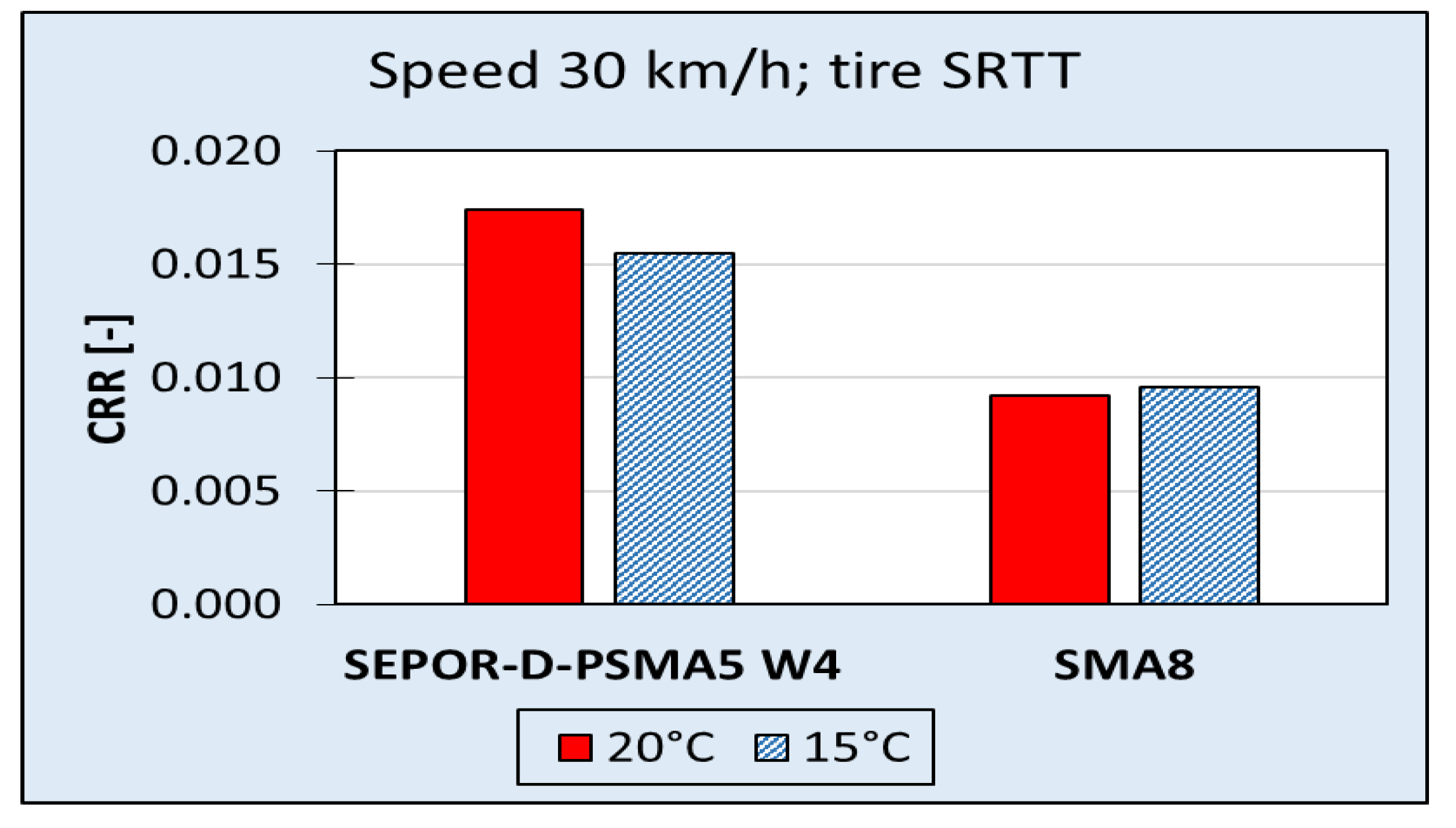
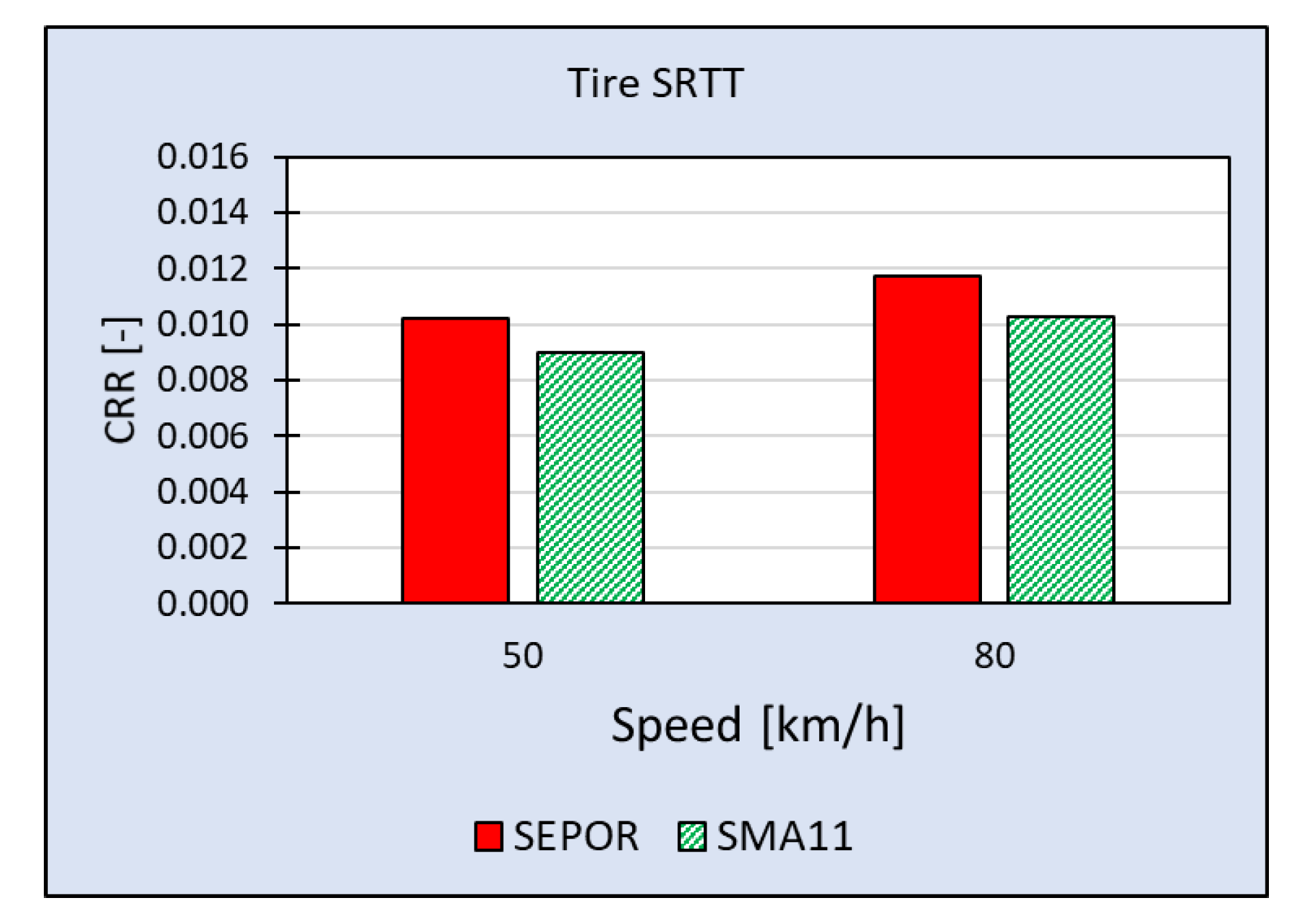
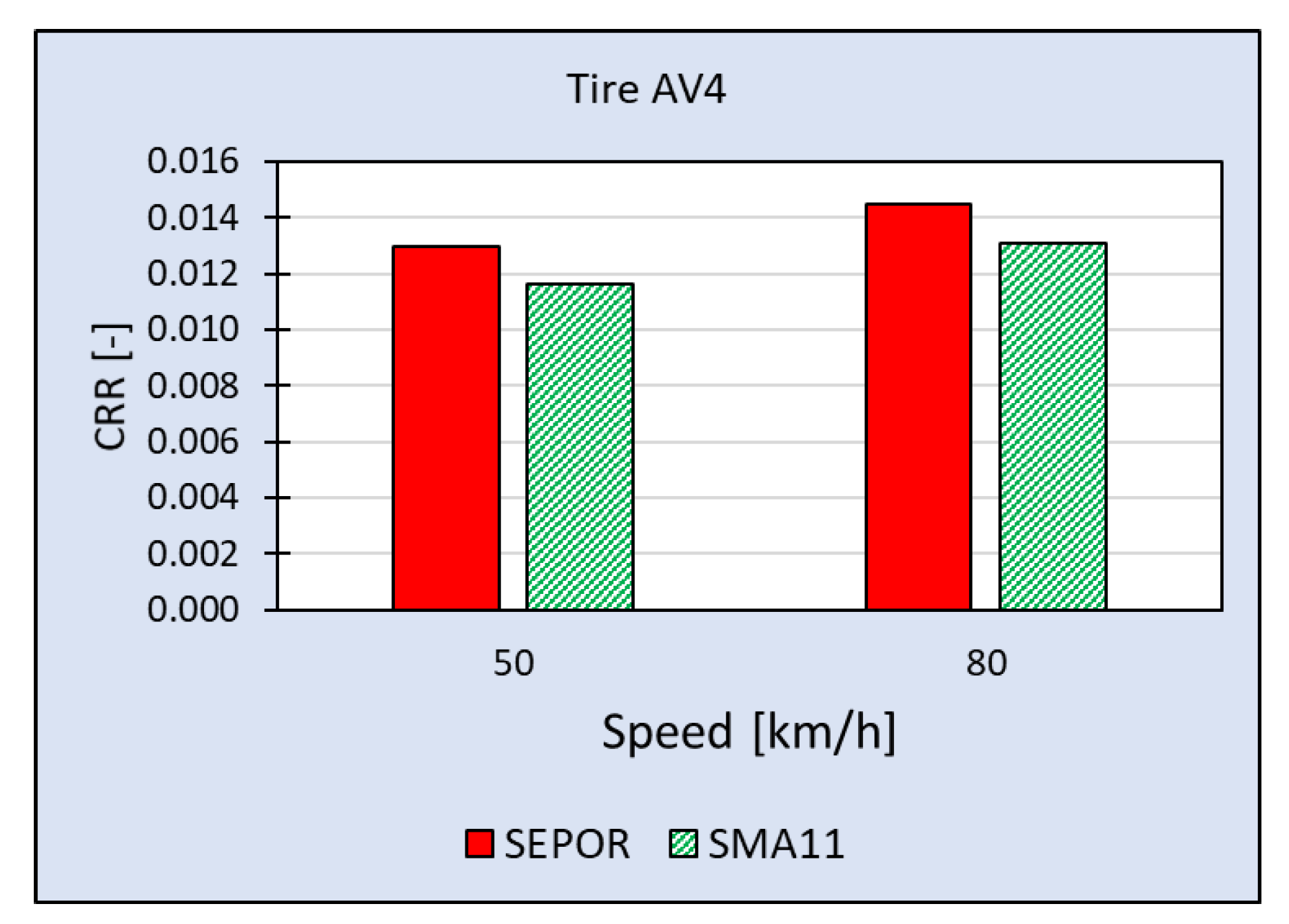
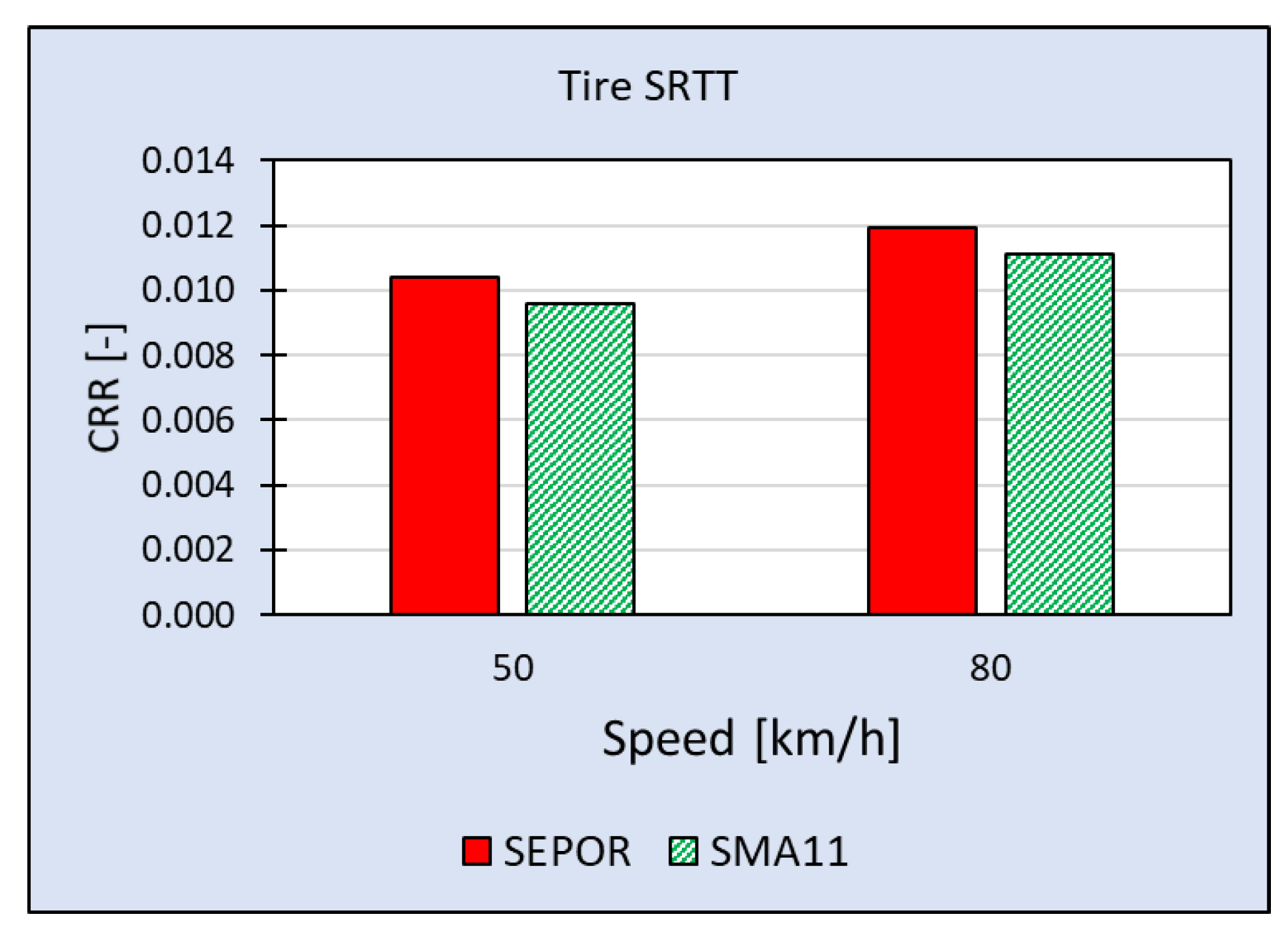
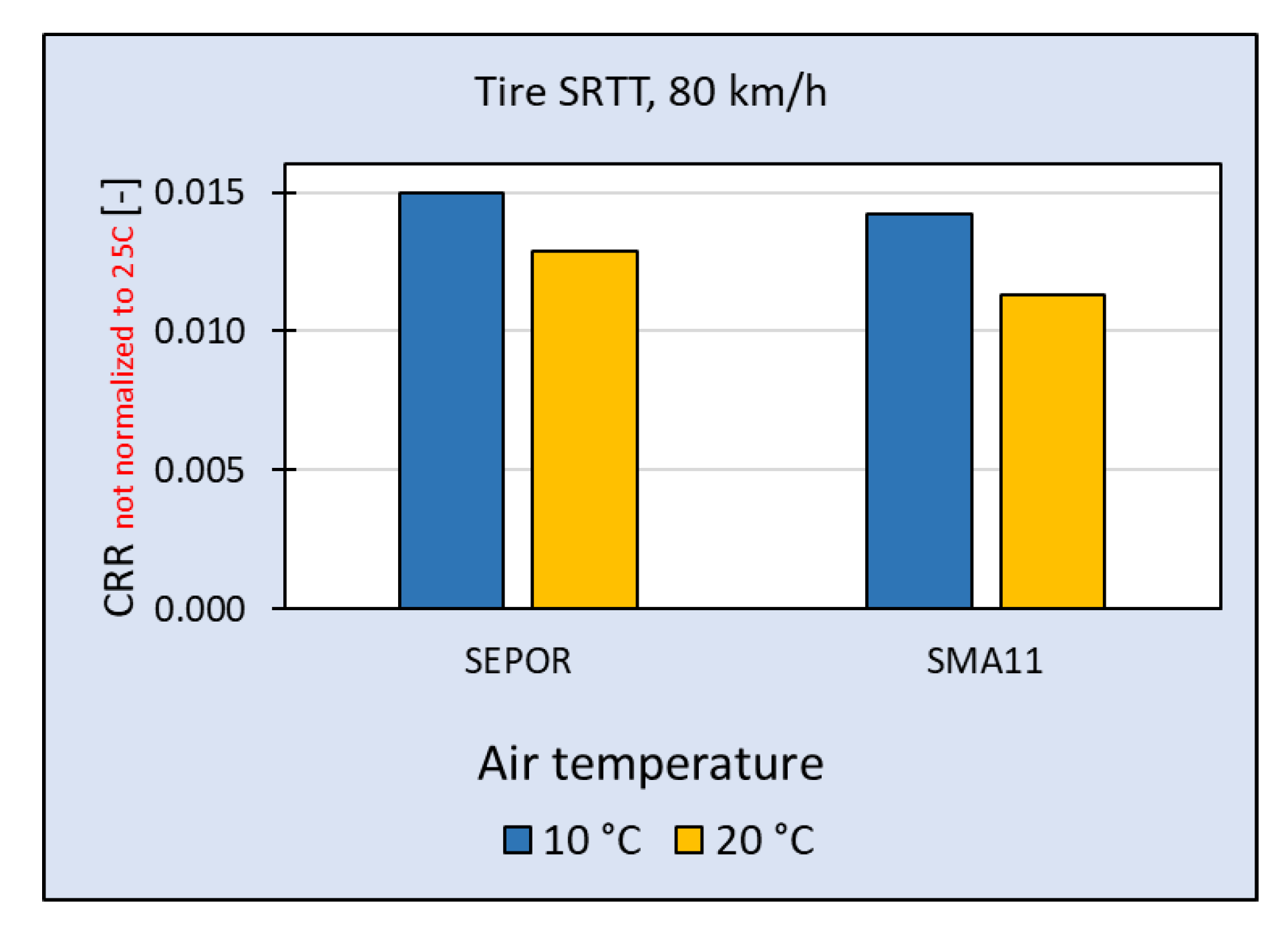
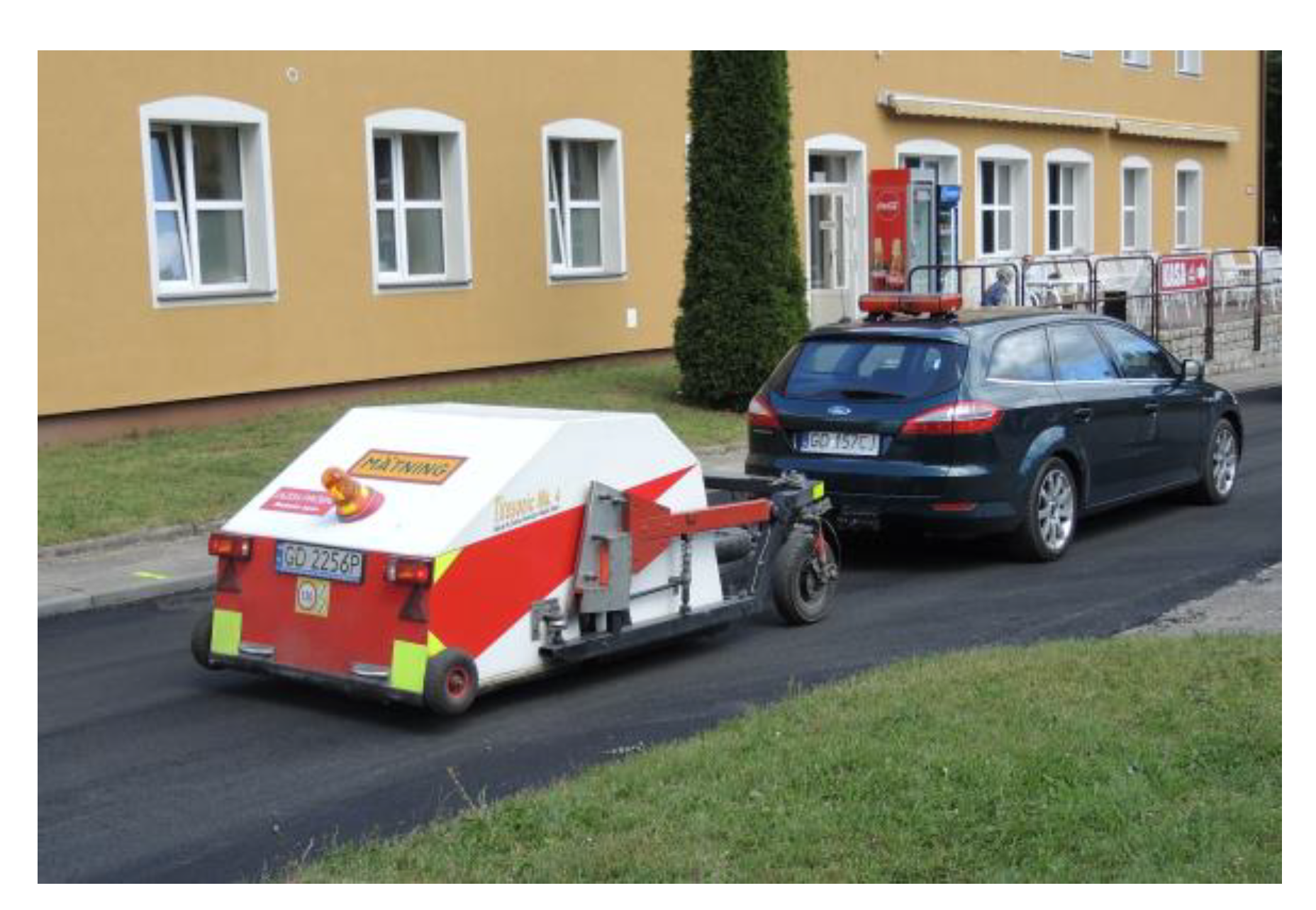
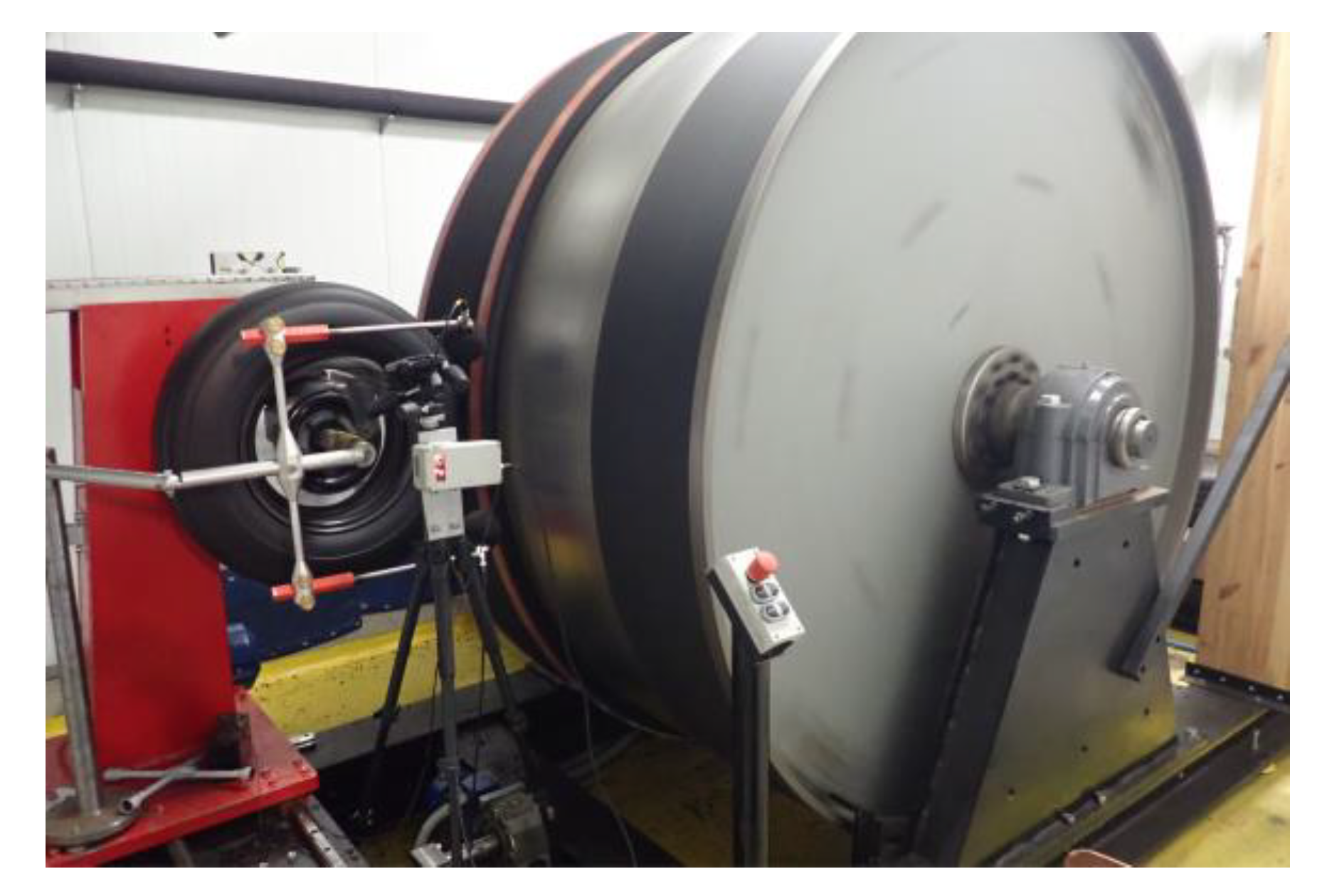
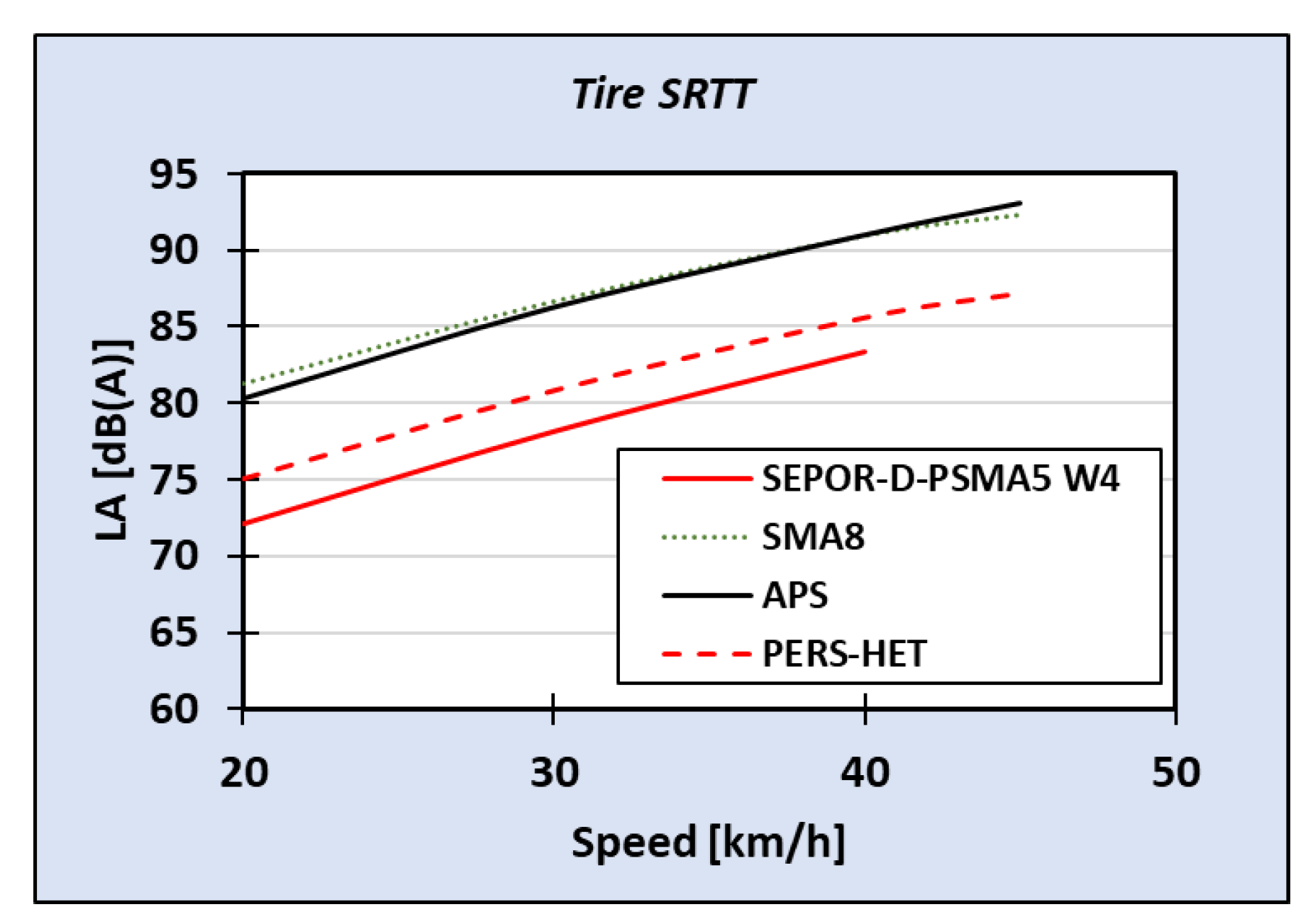
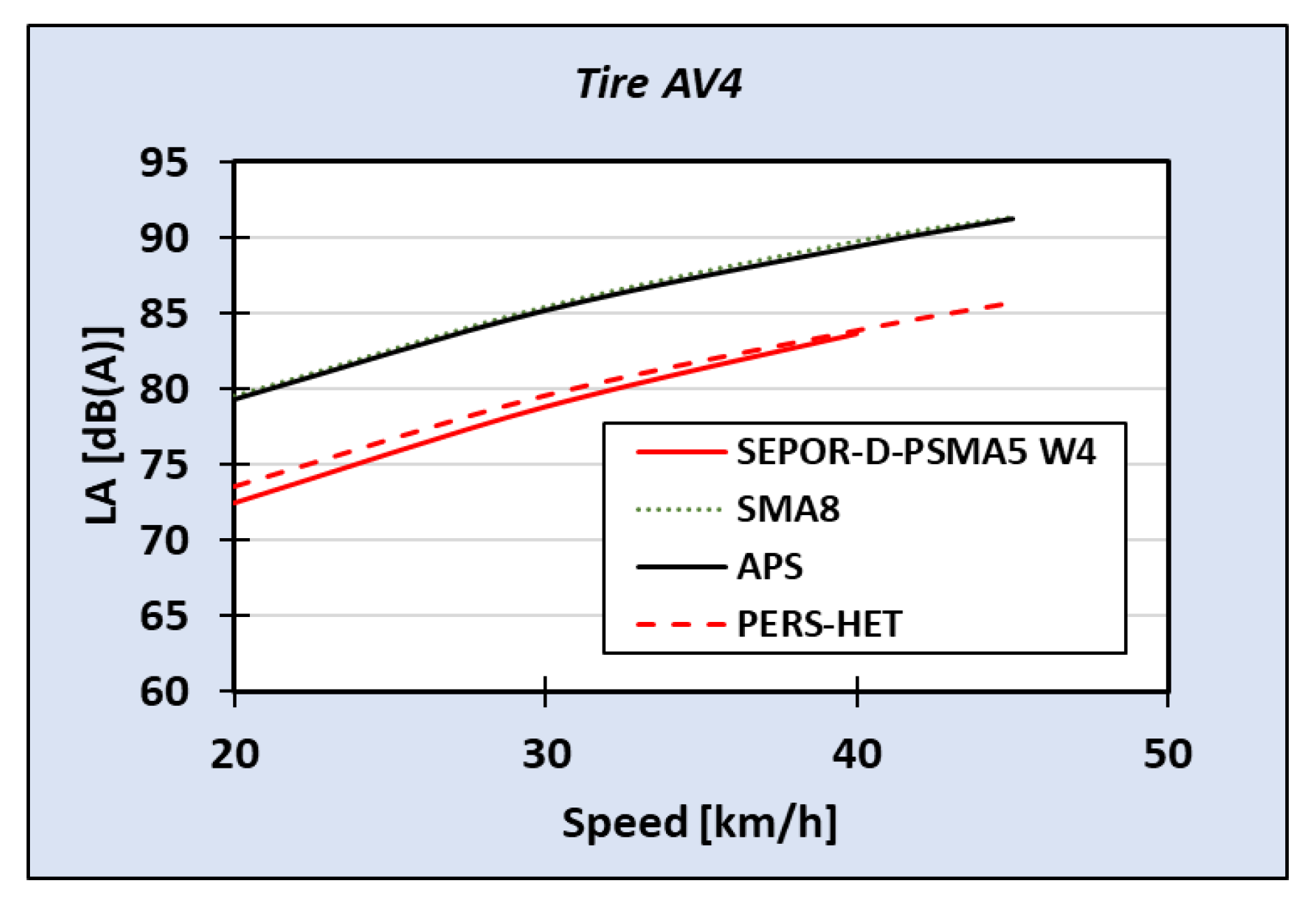
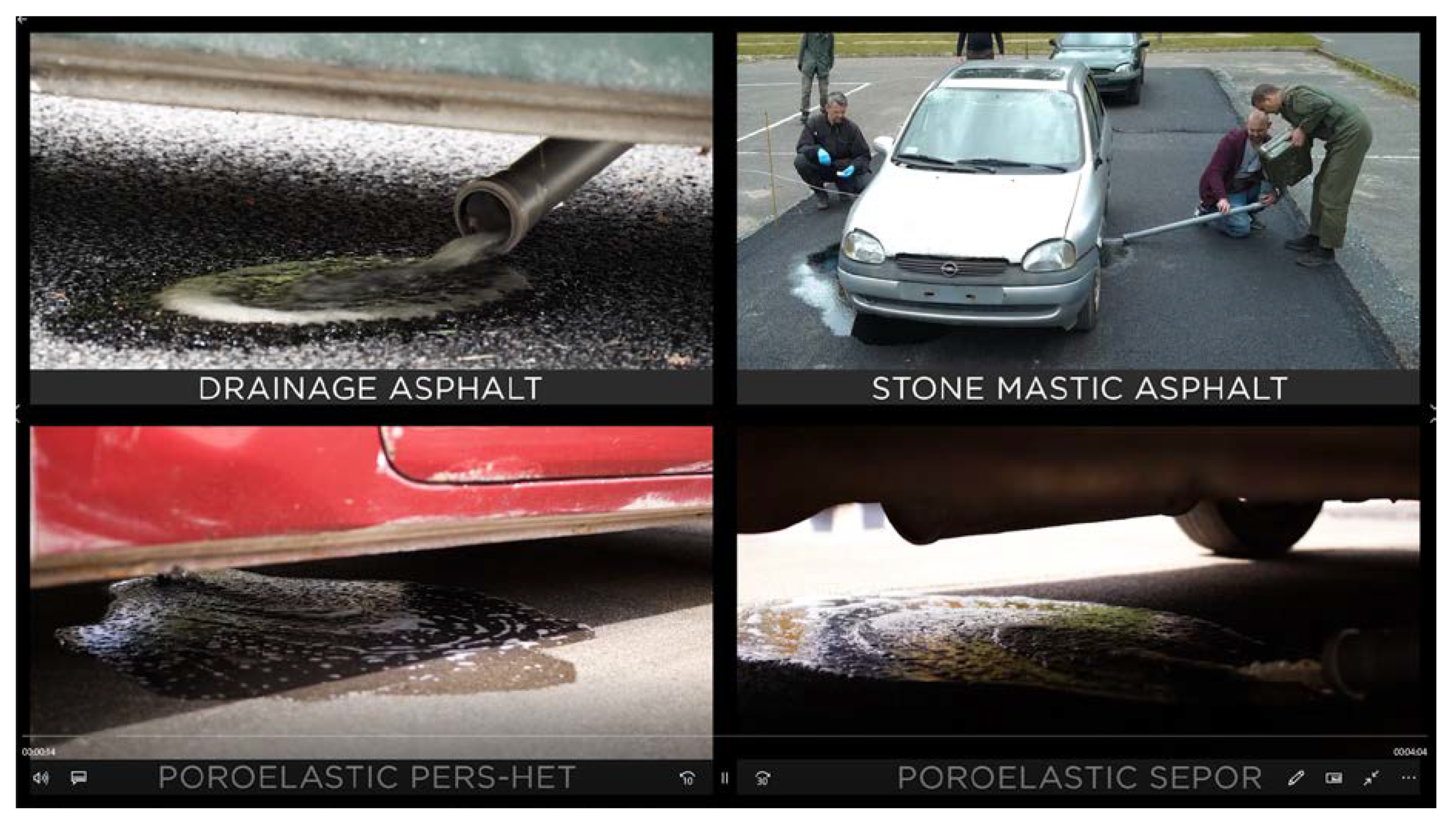
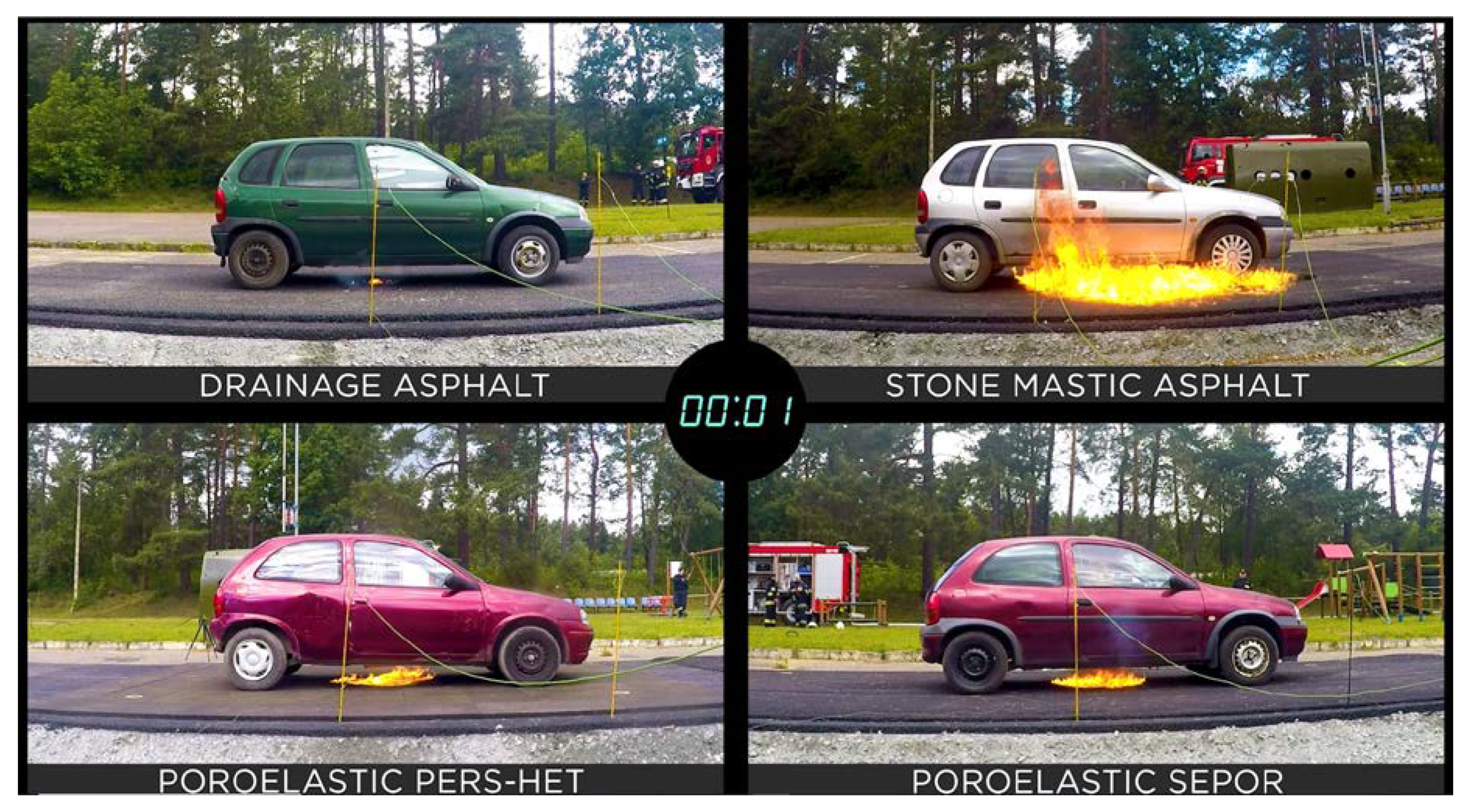
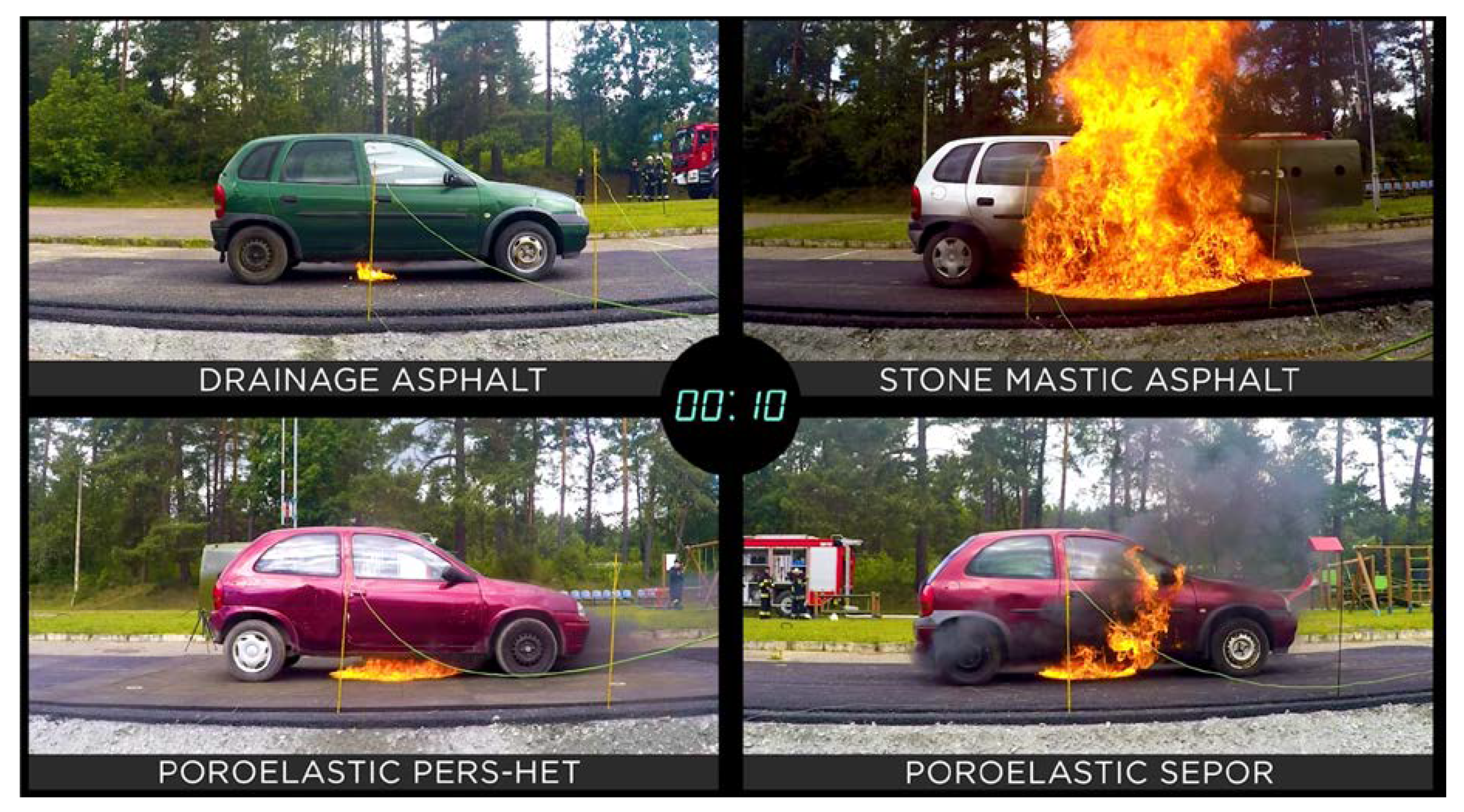

| Property | 45/80-80 | |
|---|---|---|
| Penetration at 25 °C, 0.1 mm, acc. to PN-EN 1426 | Original | 53 |
| RTFO | 40 | |
| R&B Temperature, [°C], acc. to PN-EN 1427 | Original | 78.7 |
| RTFO | 87.8 | |
| Performance Grade, acc. to AASHTO M 320 | 82-22 | |
| Resistance to heavy traffic load, acc. to AASHTO M 332 | E | |
| Mix Ingredient | Rubber–Mineral Aggregate Mix (%) | Asphalt–Rubber–Mineral Aggregate Mix (%) | |||
|---|---|---|---|---|---|
| Coarse aggregate 2/5 | 72 | 65.2 | 63.8 | 62.4 | 60.9 |
| Fine aggregate 0/2 | 6 | 5.4 | 5.3 | 5.2 | 5.1 |
| Limestone filler | 7 | 6.3 | 6.2 | 6.1 | 5.9 |
| Crumb rubber 1/4 | 10 | 9.1 | 8.9 | 8.7 | 8.5 |
| Crumb rubber 0.5/2 | 5 | 4.5 | 4.4 | 4.3 | 4.2 |
| Cellulose fibers | - | 0.4 | 0.4 | 0.4 | 0.4 |
| 45/80-80 binder | - | 9.0 | 11.0 | 13.0 | 15.0 |
| Subsection Designation | 1 | 2 | 3 | 4 | 5 | 6 | 7 | 8 |
|---|---|---|---|---|---|---|---|---|
| Amount of binder in poroelastic mixture, % m/m | 11 | 13 | ||||||
| Application of glass geogrid | No | No | No | Yes | Yes | No | No | No |
| Amount of tack coat, kg of bitumen residue per 1 m2 | 0.2 | 0.3 | 0.2 | |||||
| Type of tack coat | Bitumen emulsion C60 BP3 ZM | |||||||
| Application of longitudinal milling | No | No | Yes | Yes | Yes | Yes | No | No |
| Type of lower layer | AC16W 35/50 | SMA 11 45/80-55 | AC16W 35/50 | |||||
© 2020 by the authors. Licensee MDPI, Basel, Switzerland. This article is an open access article distributed under the terms and conditions of the Creative Commons Attribution (CC BY) license (http://creativecommons.org/licenses/by/4.0/).
Share and Cite
Jaskula, P.; Ejsmont, J.; Stienss, M.; Ronowski, G.; Szydlowski, C.; Swieczko-Zurek, B.; Rys, D. Initial Field Validation of Poroelastic Pavement Made with Crumb Rubber, Mineral Aggregate and Highly Polymer-Modified Bitumen. Materials 2020, 13, 1339. https://doi.org/10.3390/ma13061339
Jaskula P, Ejsmont J, Stienss M, Ronowski G, Szydlowski C, Swieczko-Zurek B, Rys D. Initial Field Validation of Poroelastic Pavement Made with Crumb Rubber, Mineral Aggregate and Highly Polymer-Modified Bitumen. Materials. 2020; 13(6):1339. https://doi.org/10.3390/ma13061339
Chicago/Turabian StyleJaskula, Piotr, Jerzy Ejsmont, Marcin Stienss, Grzegorz Ronowski, Cezary Szydlowski, Beata Swieczko-Zurek, and Dawid Rys. 2020. "Initial Field Validation of Poroelastic Pavement Made with Crumb Rubber, Mineral Aggregate and Highly Polymer-Modified Bitumen" Materials 13, no. 6: 1339. https://doi.org/10.3390/ma13061339
APA StyleJaskula, P., Ejsmont, J., Stienss, M., Ronowski, G., Szydlowski, C., Swieczko-Zurek, B., & Rys, D. (2020). Initial Field Validation of Poroelastic Pavement Made with Crumb Rubber, Mineral Aggregate and Highly Polymer-Modified Bitumen. Materials, 13(6), 1339. https://doi.org/10.3390/ma13061339







